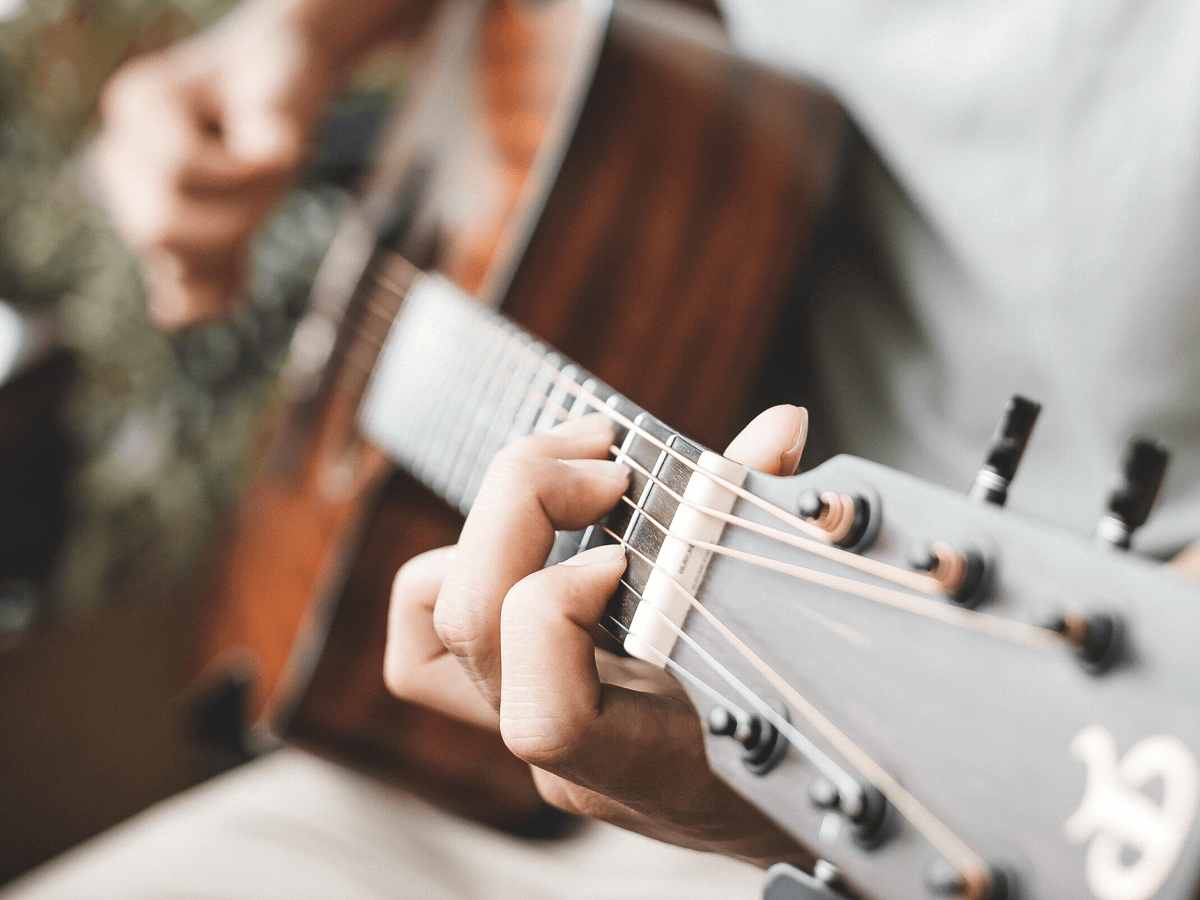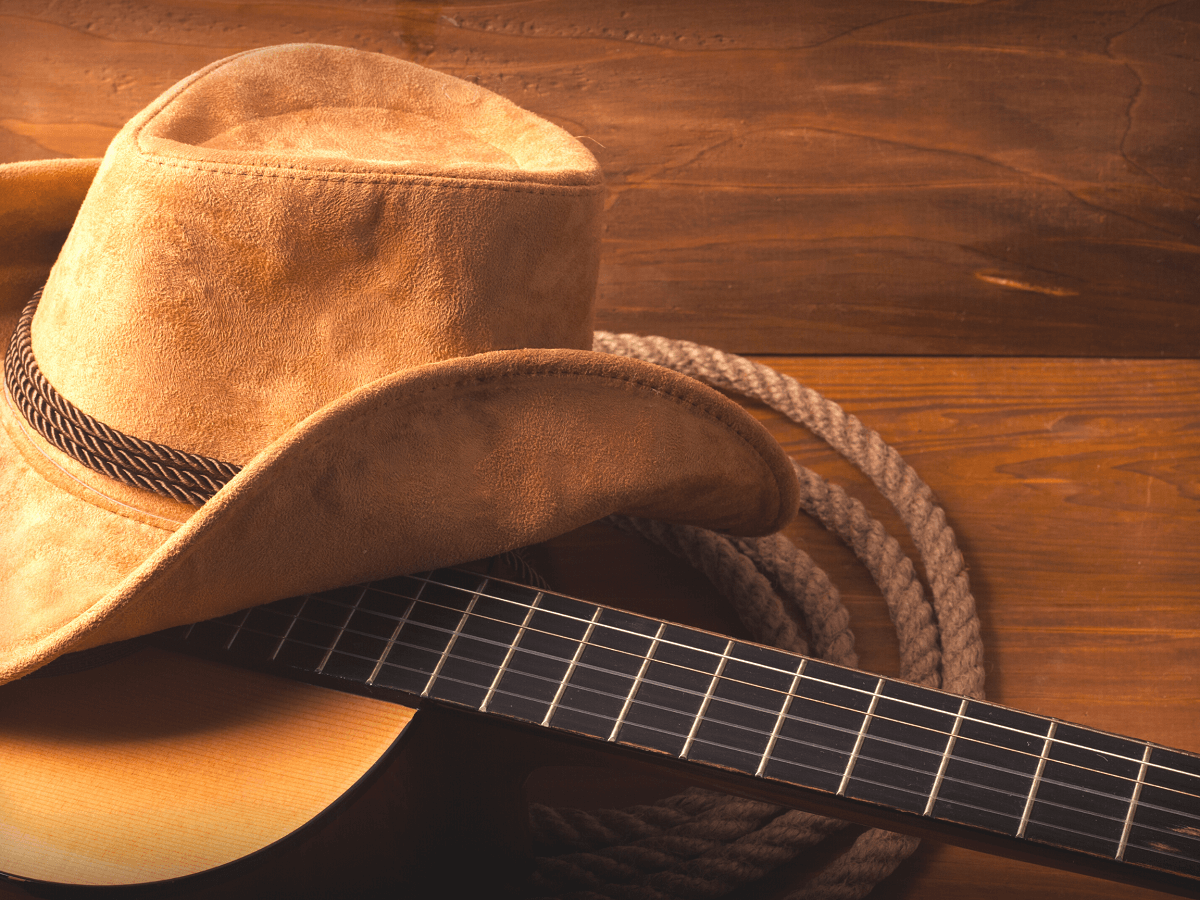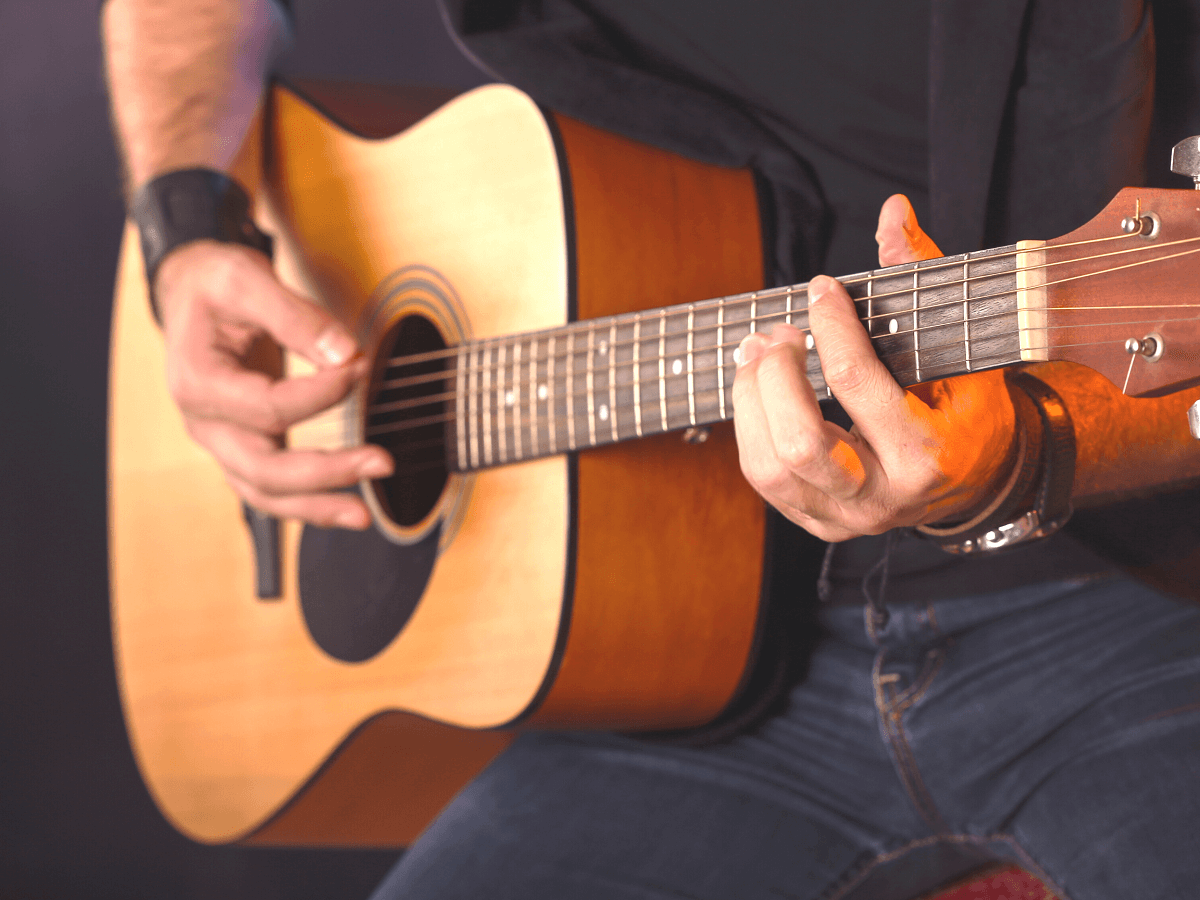As a musician, your choice of equipment is crucial to your performance.
One of the most important pieces of equipment for any guitarist is undoubtedly their instrument of choice.
Primarily, an acoustic guitar can make a significant difference not just in the quality of your performance but also in your personal comfort and ease of play.
Choosing the right acoustic guitar for performing live may seem like a daunting task given the sheer variety of options available.
To ensure that your guitar matches both your budget and your musical requirements, some key factors need to be taken into consideration.
Continue reading for a deep-dive into these critical aspects and to explore some of the top acoustic guitars that are perfectly suited for live performances.
Table of Contents [show]
Best Acoustic Guitars For Gigging
Before I begin, here are my top selected choices:
|
|
Seagull S6 Original Acoustic Guitar

North American made, unique tone, easy tuning. Check Price
|
PRS SE P20E Parlor Acoustic-Electric Guitar

Exceptional resonance, premium features, and elegant aesthetics.
Check Price
|
Guild F-55 Maple Acoustic Guitar
Known for its exemplary classic design.
This robust 6-string acoustic guitar is known for its exemplary classic design. It is outfitted with a spruce top, maple back sides, and a mahogany/walnut neck with an ebony fingerboard. Further noteworthy specifications include right-hand orientation, an antique burst color, and materials like spruce wood for the top and maple wood for the body, back, neck, and fretboard.
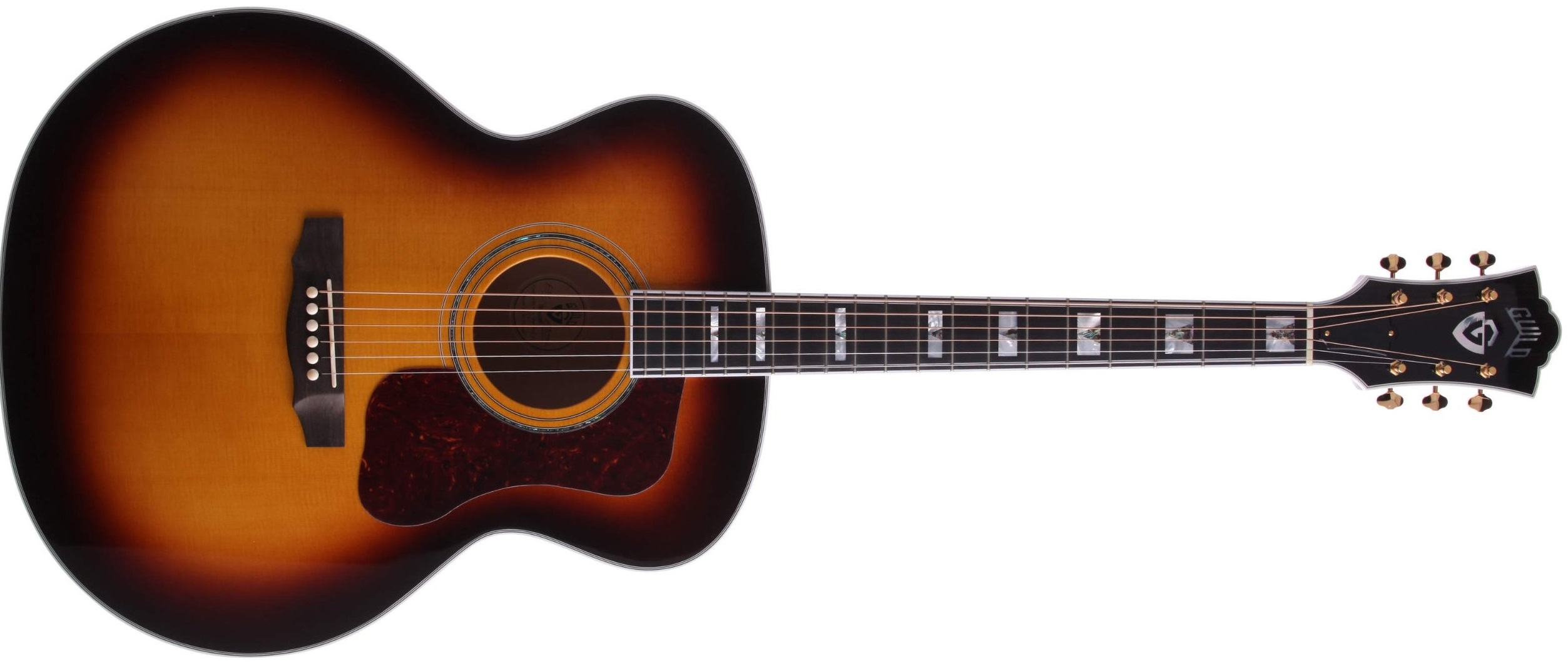
The Guild F-55 Maple is an exquisite guitar model that is both jumbo in size and produces high-quality sound.
This jumbo acoustic guitar features a beautiful Antique Burst color, making it not just an instrument but a visual piece of art.
The guitar’s top is crafted from high-quality Spruce wood, featuring a natural resistance to dampness and change in temperature, allowing the guitar to withstand different environments.
With a fingerboard made from Ebony, the guitarist would experience an incredibly smooth playing surface that helps to achieve a rich sound.
This guitar has a neck made from Mahogany and Walnut, ensuring durability and stability for prolonged use.
Its back and sides are made of Maple wood, aiding in sound amplification and producing a tone that is bright and powerful.
Constructed by the well-known brand Guild, this guitar is designed for right-handed individuals and is equipped with six strings.
Without a doubt, this Guild F-55 Maple, Jumbo Acoustic Guitar is an embodiment of exceptional craftsmanship that allures by its Classic Guild Jumbo style.
- My Review
Upon getting my hands on the Guild F-55 Maple, Jumbo Acoustic Guitar, the antique burst color immediately caught my attention.
Rich mahogany and walnut are combined masterfully to construct the guitar’s neck, demonstrating an excellent blend of strength and flexibility.
Quality maple wood used for the back and sides provides a robust resonance that really compliments the guitar’s jumbo size.
I took note of the ebony fingerboard, which provided a smooth surface that’s both visually impressive and noticeably comfortable during extended play.
I couldn’t help but marvel at the guitar’s top material – spruce wood, an ideal choice for maximizing tonal quality.
With this choice of material, the guitar can deliver a full-bodied sound along with a clear and well-rounded tone.
This Guild Acoustic Guitar, being a 6-string model, allows for a diverse range of playing styles.
Whether you are an enthusiastic strummer or a precise picker, you’ll find this guitar offering a compelling tonal palette.
One aspect I particularly enjoyed was its right-hand orientation, catering to the larger demographic of guitarists.
The guitar’s size, combined with its jumbo shape, facilitates outstanding resonance that can produce a significant volume boost, perfect for performing in large environments.
Despite its size, I noticed that the guitar maintains a well-balanced sound, whether you are playing the high or low notes.
Something about the Guild F-55 that cannot be overlooked is its striking aesthetic.
The antique burst finish contrasts beautifully with the maple body, making the guitar as visually pleasing as it is to play.
Furthermore, it’s evident that the construction of this instrument is high-quality and designed to last.
On the whole, it’s clear that a lot of thought has gone into the design of this Guild F-55 Maple, Jumbo Acoustic Guitar.
Fusing quality material with precision craftsmanship, this model is certainly a treasure for any guitar enthusiast’s collection.
Despite the instrument’s size, it’s perfectly balanced, providing an exceptional playing experience that is both comfortable and rewarding.
In my experience, this guitar truly embodies superior sound quality and gorgeous aesthetics, a combination that Guild has so successfully mastered.
- Pros:
- High-quality Spruce top.
- Maple back and sides.
- Mahogany/Walnut neck.
- Cons:
- May be pricey for some.
My final verdict is that the Guild F-55 Maple, Jumbo Acoustic Guitar – Antique Burst is a top-notch acoustic guitar with an exquisite antique finish.
The spruce top and maple back sides standout for their quality and contribute greatly to the guitar’s sound production.
It is perfectly suited for right-hand orientated players with the ease of play made possible by the ebony fingerboard.
The jumbo size enhances the resonance and volume, making it ideal for performances.
This guitar is a testament to Guild’s commitment to quality and superb craftsmanship.
PRS SE P20E Parlor Acoustic-Electric Guitar
Exceptional resonance, premium features, and elegant aesthetics.
This mahogany parlor guitar delivers an impressively dynamic voice and natural projection. Its antique white finish and herringbone accents add style, while the Fishman GT1 pickup captures the nuance of your playing. The guitar’s combination of premium features and unique aesthetics makes it a standout addition to your musical instruments.
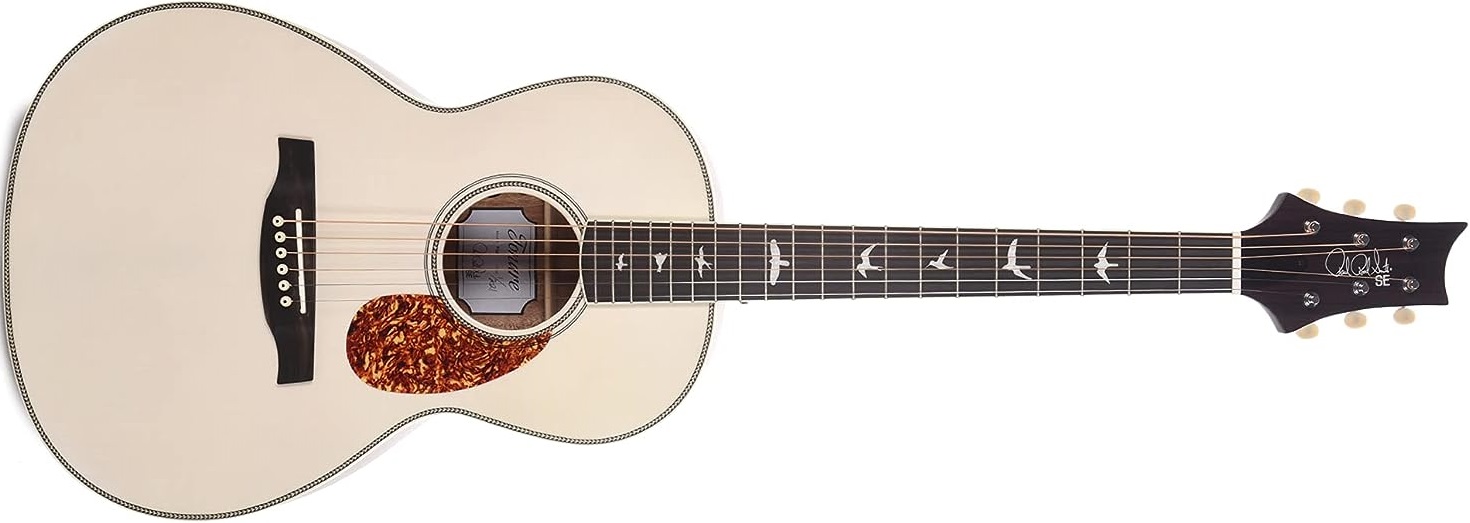
Paul Reed Smith’s special edition, SE-P20E, is part of the unique parlor guitar family known for its astonishingly substantial sound and volume despite its compact structure.
Boasting an attractive antique white finish, the guitar has a solid mahogany top paired with mahogany back and sides, contributing to its superior acoustics and rich tonal clarity.
This guitar features a Wide Fat Style neck crafted from mahogany, with an elegant ebony fingerboard embellished with the famous bird inlays from PRS.
Another noteworthy feature is the genuine bone nut and saddle, offering even more tonal benefits to this premium instrument.
The aesthetic appeal is enhanced by the refined herringbone rosette and accents, which contrast beautifully with the smooth antique white finish.
The thing that sets the SE-P20E apart is the Fishman GT1 under-saddle pickup system. This system captures the natural vibrations, faithfully echoing your playing style and excluding any annoying feedback.
The controls are sneakily placed inside the sound hole for simple access, but are hidden from the viewer’s eye.
This guitar also includes a PRS gig bag for convenient transportation without compromising on the instrument’s protection.
The major takeaway? This guitar isn’t just about the looks, it’s about delivering superior performance and quality.
- My Review
When I first laid my hands on the PRS Limited Edition SE P20E Parlor Antique White w/Fishman GT1, I was immediately struck by the elegant and unique aesthetic of its Satin Antique White finish.
Upon further inspection, I noticed the intricate herringbone rosette and accents around the body and soundhole, adding an air of sophistication.
The make of the guitar comprises of a trio of woods – Ash Wood, Mahogany and Ebony, each chosen for their unique acoustic properties and contributions to the overall resonance and sound clarity.
Moreover, the guitar features a Fishman GT1 Under-Saddle Pickup System that does an impressive job of sensing natural vibrations to deliver the character of your playing when plugged in.
What I found particularly pleasing was the design of the controls, discretely placed within the sound hole, hidden from the audience’s view but easy to access.
On strumming, the Solid Mahogany Top and Mahogany Back Side indeed deliver an exceptional resonance, capturing the subtleties of my playing style.
Despite the smaller sized body, there was no compromise on the large dynamic voice and impressive natural projection, living up to the legacy of Parlor guitars.
As someone with experience in guitar maintenance, I did find some areas of improvement.
The saddle piece was initially a tad too tall, rendering the action a bit challenging, and the tuning mechanism did seem to be of a low grade, making the intonation tricky to get right.
Nevertheless, these issues were manageable – a shorter saddle piece and a better set of tuners easily rectified the problems.
The lighter weight of the PRS Limited Edition SE P20E Parlor Antique White w/Fishman GT1 makes it the ideal choice for people dealing with physical conditions affecting their ability to handle traditional guitars.
From the first strum, I could tell that the PRS SE-P20E truly captures the vintage parlor-style tone.
Its carefully chosen tonewoods – primarily mahogany – deliver a warm, rich tone that enhances the depth of the songs you play and truly brings them to life.
Whether you’re a seasoned professional or just picking up the hobby, this guitar is an investment worth considering.
While it may require a bit of initial fine-tuning in terms of action and intonation, it is worth noting that the end result is a versatile, beautiful sounding, and easy-to-play instrument.
- Pros:
- Lightweight and portable design.
- Exceptionally large dynamic voice.
- Premium materials and aesthetics.
- Cons:
- Possible intonation issues.
- Initial high action reported.
- Potentially lower-grade tuners.
My final verdict is that the PRS Limited Edition SE P20E Parlor Antique White w/Fishman GT1 is truly a fantastic guitar.
Its exceptional resonance and supreme sonic clarity are absolutely off the charts.
The subtle yet elegant aesthetics make it not just an instrument, but a piece of art.
And the addition of the Fishman GT1 undersaddle pickup system makes it an excellent choice for stage performances.
Its unique features and impressive sound quality make it a standout option for guitar enthusiasts.
Breedlove Oregon Concerto CE Acoustic-Electric Guitar
Exceptional sound and sustainability in one guitar.
This guitar features a myrtlewood top and a maple neck, back, and sides for optimal sound. It has an ebony fingerboard, LR Baggs EAS VTC pickup, and is strung with phosphor bronze for exceptional playability. The guitar is constructed by Breedlove using sustainable methods and innovative sound optimization processes.
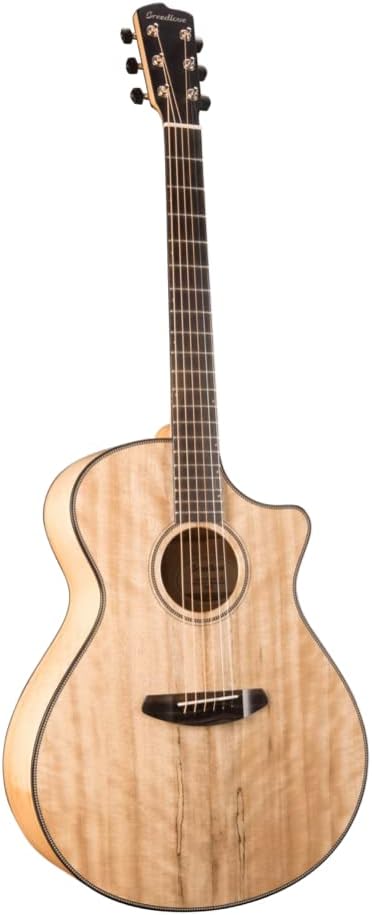
The Breedlove Oregon Concerto CE is an acoustic-electric guitar that’s equipped with a myrtlewood top and a 6-string configuration.
It sports an elegant natural finish, complemented by a maple neck, sides, and back.
The beautiful ebony fingerboard is encased in pristine maple and ebon wood which gives it a defining texture.
This guitar is not just about looks, but it’s also about functionality. It adopts the LR Baggs EAS VTC pickup configuration, aiding in sound amplification and adjustment during your performances.
Constructed with phosphor bronze strings, the guitar is tailored for right-hand orientation.
Produced by Breedlove, a renowned brand that emphasises on sustainable practices, every part of the guitar is made from materials that do not promote deforestation.
Their innovation came into play with the Sound Optimization process, which ensures the specific densities of wood contribute to optimal sound resonance.
It’s interesting to note that it’s no ordinary guitar, but one which has been crafted with myrtlewood, a rare tonewood known for its uniform cellular structure, enhancing its sound quality according to expert luthier Cyril Jacobs.
This model encourages versatile playing style – whether it’s strumming or fingerpicking – prioritizing ergonomic comfort, and offering a balanced, articulate sound.
It showcases a unique smaller body design, ensuring a clear, crisp sound, with the added advantage of effortless manoeuvrability.
- My Review
Firstly, I must say there’s something particularly endearing about the Breedlove Oregon Concerto CE Acoustic-Electric Guitar.
Being a 6-string Acoustic-electric Guitar, its sound is undoubtedly articulate.
What struck me first was the natural Myrtlewood top of the guitar; an aesthetically appealing feature that simply added to the overall charm.
As I strummed the sturdy strings, made of Phosphor Bronze, the instrument resonated with a kind of sonic warmth and vitality that I found to be breathtaking.
Running my fingers along the ebony fingerboard, I noticed how effortlessly my fingers glided from one fret to another.
The guitar’s body, neck, sides, and back are made of a beautiful Maple wood, which, apart from its visual appeal, is also renowned for its tonal quality and durability.
The LR Baggs EAS VTC pickup configuration gave me the freedom to tinker with the sound and tone as per my preference, a feature I deeply appreciate in any acoustic-electric guitar.
The instrument’s hand orientation is designed for right-handed players, which, I admit, suits me perfectly.
While I played, I noticed how the Breedlove Oregon Concerto CE projected a loud, textured sound, indeed exceeding my expectations from its relatively compact size.
What deeply impresses me about this Breedlove guitar is the brand’s commitment to Sound Optimization, which speaks volumes of their dedication towards creating superior quality acoustic-electric guitars.
It’s interesting to find out that the process takes into account the specific densities of wood sets; top and back frequency separation, leading to a rich, well-rounded sound.
The fact that no clear cut wood is used in the construction of these guitars is deeply commendable, showing Breedlove’s dedication to sustainably-built, eco-friendly instruments.
I played on, exploring the range of sounds, and the blend of the warmth of myrtlewood and the crispness of maple made each chord a unique experience.
This Breedlove guitar is designed for journeys, ready for all paystyles, and above all, guarantees a sound that’s as unique as the player.
The Cascade bracing, born from years of specific data collection, adds strength and resonance to the guitar, enhancing the overall acoustic experience.
Finally, the story behind Myrtlewood, this exceptional tonewood with the most uniform cellular structure on the planet, makes me believe that each strum on this Breedlove guitar ties me to a legacy nuanced with science, art, and passion.
- Pros:
- Exceptional Myrtlewood tonewood.
- Sound Optimization technology.
- Sustainably built, eco-friendly design.
- Cons:
- May be pricy for some.
- Specific sound may not suit all.
My final verdict is that the Breedlove Oregon Concerto CE Acoustic-Electric Guitar stands out with its unique blend of materials.
Its sustainable construction makes it a future-oriented purchase for ethically conscious musicians.
The use of Myrtlewood as a tonewood adds a distinctive quality to its sound.
Moreover, Sound Optimization embodies Breedlove’s marriage of science and art, making this guitar a true masterpiece of acoustics.
This instrument offers a perfect balance of splendid craftsmanship, robust sound, and sustainability.
Taylor 814ce Acoustic-Electric Guitar
Premium woods and V-Class bracing for superior sound.
This acoustic-electric guitar features a spruce top, Indian rosewood back and sides, and a mahogany neck with an ebony fingerboard. It stands out with its V-Class bracing and radiused armrest design. With an ash, maple, rosewood, mahogany, ebony, and spruce top and a right hand orientation, it’s suitable for versatile musical styles.
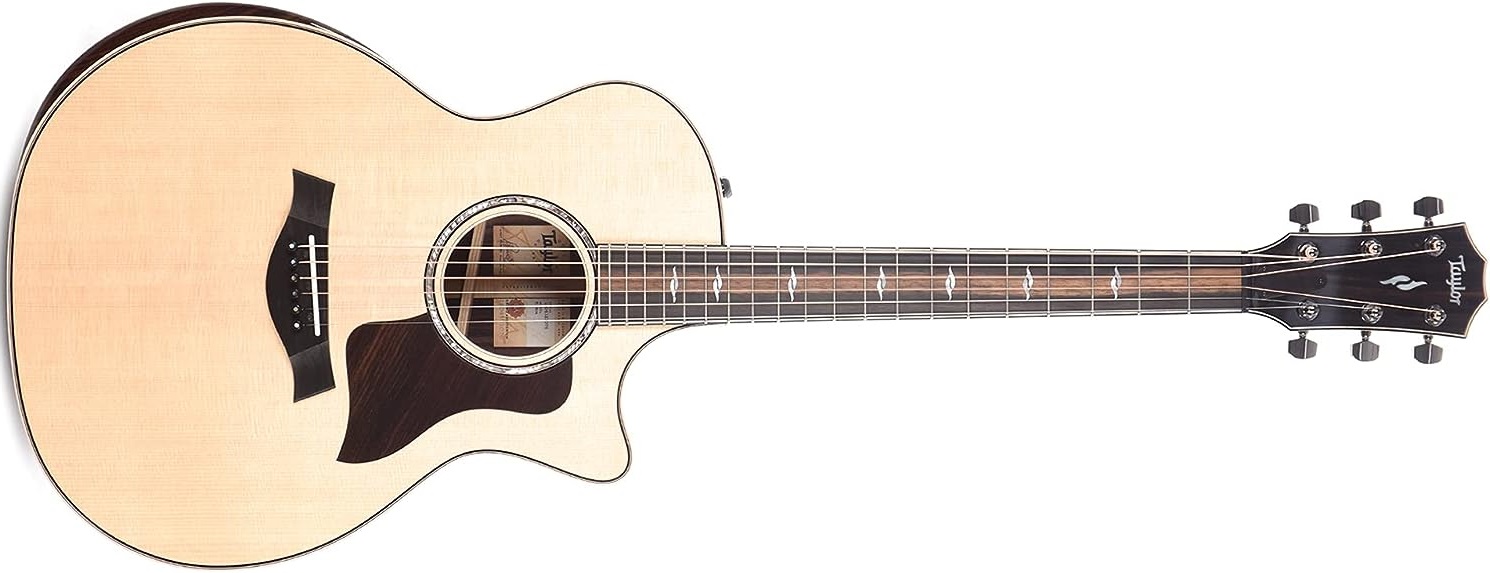
Made by the well-renowned brand, Taylor, the 814ce acoustic-electric guitar is a remarkable instrument, masterfully crafted.
Its charm lies in the natural color enhancing the overall appearance, which is a sight to behold.
Interestingly, various types of wood, including Ash, Maple, Rosewood, Mahogany, Ebony and Spruce, have been meticulously used in its construction.
This piece primarily entails Rosewood as its body material, lending it an exquisite look and phenomenal durability.
Notably, the back of the guitar pivotally features both Rosewood and Mahogany wood, making it sturdy yet lightweight.
With the neck of the guitar being fabricated from Mahogany, it is not only durable but also provides an exceptional feel when held.
Adding to its unique quirks, it features a fretboard constructed out of Mahogany wood, accentuating its grandeur.
The guitar strings are made from Nickel, providing an extra edge in terms of sound quality.
Designed specifically for right-handed individuals, this guitar is versatile and user-friendly.
An impressive feature is its 25.5-inch scale length, offering a comfort fit for any player.
Lastly, Taylor’s 814ce guitar comes with the distinctive feature of V-Class Bracing, and a specially designed radiused armrest, contributing to its superior playability and sound.
- My Review
Having had the opportunity to try out the Taylor 814ce Acoustic-Electric Guitar, what strikes me first is its eye-catching natural finish.
Constructed with a mixture of top-quality materials including ash, maple, rosewood, mahogany, ebony, and spruce, which each contribute a unique tone and durability to the overall instrument.
The choice of rosewood for the body and back sides creates a rich, warm tone that resonates beautifully, while the ebony fingerboard offers a smooth playing experience.
Another detail worth mentioning is the use of V-Class Bracing in this guitar, which gives it a distinct sound and adds to its overall performance.
The neck, made of mahogany, is beautifully crafted and suggests longevity of use.
What struck me most about this model is the addition of a radiused armrest – a seemingly small detail that enhances the player’s comfort immensely.
However, just as crucial as the materials used in the guitar’s construction are its ergonomic qualities – as it is crafted with a right-hand orientation and a scale length of 25.5 inches.
Fretting notes and chords on this guitar feels effortless due to its hand-friendly features.
Providing this instrument with its characteristic sound are the nickel strings, which produce a bright, clear tonality.
It’s worth mentioning that the craftsmanship behind the creation of this guitar is top-notch, in line with the reputation that comes with the Taylor brand name.
Irrespective of your playing style, it seems like this guitar is capable of accommodating a wide array of musical genres.
Nonetheless, no product is without its shortcomings and there are few areas where the Taylor 814ce could see improvements.
Most notably, it is important to note that this guitar’s price tag may put it out of reach for beginner or budget-conscious musicians.
Moreover, tinkering with the instrument’s settings might be daunting to some, given the acoustic-electric hybrid nature of this guitar.
Despite these few drawbacks, as an overall review, the Taylor 814ce Acoustic-Electric Guitar stands as an impressive instrument, combining a range of premium materials and an innovative structural design.
- Pros:
- High-quality Rosewood and Mahogany materials.
- V-Class Bracing for superior sound.
- Comfortable Radiused Armrest.
- Cons:
- Right-hand orientation only.
- Price might be high for some.
My final verdict is that the Taylor 814ce Acoustic-Electric Guitar is a top-notch instrument with a visually stunning design and exceptional sound quality.
Featuring a solid build, V-Class Bracing, and a comfortable Radiused Armrest, it offers the perfect blend of comfort and professional sound for any player.
I’m particularly impressed by its Indian Rosewood Back Sides and Mahogany neck, contributing to its rich and warm tonal quality.
The variety of premium materials used, from Maple and Ebony wood to Nickel strings, optimizes its overall performance.
Therefore, I highly recommend the Taylor 814ce for both seasoned players and beginners looking for a top-tier guitar.
Martin D-28 Acoustic Guitar
Rich history meets modern enhancement.
The Martin 2017 D-28 guitar incorporates reinvented features to offer a modern playing experience. It blends classic elements like vintage appointments with new enhancements such as forward-shifted bracing for superior vibration. With a legendary lineage and iconic musicians as its users, this guitar seamlessly combines tradition and innovation.
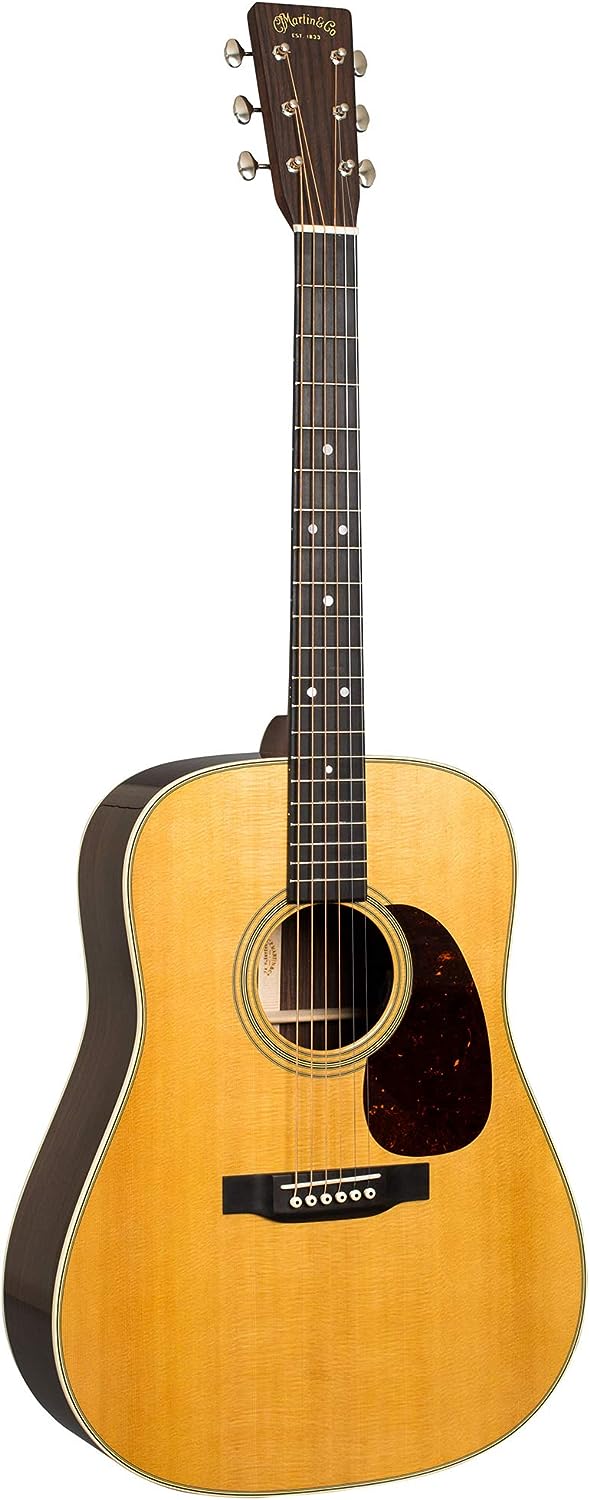
Inspired by the iconic D-28 model, the Martin Dreadnought Acoustic Guitar comes in a nondescript natural color.
Martin has modernized the look of this classic, introducing details that make the instrument stand out.
The guitar’s body is constructed from Rosewood, as well as the fretboard.
Martin has used Spruce Wood for the top material type, known for its warm tones.
The guitar boasts a Solid headstock with features like a square taper and diamond inlay.
The neck of this guitar is made of mahogany, ensuring strength and stability.
The SP Acoustic 92/8 Phosphor Bronze Medium (MSP4200) strings and the multi-stripe top, along with back inlays, further enhance the aesthetic appeal and sound quality of the instrument.
Notably, Martin has integrated antique white accents and a forward-shifted bracing pattern that allows the top to vibrate more freely, creating a rich and full-bodied sound.
The instrument also has Style 28 mother-of-pearl fingerboard inlays, providing a luxurious touch. It comes with a right-hand orientation and is designed for six-string guitar players.
Matching vintage features with Martin’s renowned innovations, this guitar boasts open gear tuners and an aged toner top.
There’s also a faux tortoise pickguard, which adds to its overall vintage appeal.
In the words of Chris Martin, the CEO of Martin Guitar, they have managed to bring together the finest features of different versions of the D-28.
These have been in use over different eras, incorporating them into a guitar with a modern feel and comfortable playing experience.
Along with the mentioned specifications, the Dreadnought guitar comes with accessories such as Authentic Acoustic Strings, LUXE Signature Strings, and various guitar care items.
These are representative of Martin’s commitment to quality and the ongoing legacy of the brand.
- My Review
From the moment I strummed the first chord on the Martin D-28 Dreadnought Acoustic Guitar, a captivating tone resonated from the spruce wood top, signaling the immense potential of this instrument.
Its sound, with each chord strummed and each note picked, epitomizes the excellence of Martin craftsmanship in creating fine acoustic guitars, standing out as a testament to their longstanding tradition of quality.
The D-28 Dreadnought is not just a guitar, but a work of art, marrying the simplicity of its plain, natural wood design with an authentic feel in my hands that helps me understand just why it has continued to be a favorite among countless musicians, from legends of the past to the artists of today.
What impressed me the most about the Martin Dreadnought is the sense of history and tradition that its design encapsulates, from the top material type being spruce wood to the body and back material type being rosewood.
Each detail of the Martin D-28, down to the antique white binding and the aging toner, beckons to excellence in artistry and performance, making it every bit an iconic acoustic guitar.
An integral part of this guitar’s charm is the forward shifting non-scalloped X bracing that allows for greater top vibration, resulting in a beautiful, rich tone every time.
Not to mention the mother-of-pearl fingerboard inlays, which add just the right touch of elegance to this timeless piece.
However, the Martin D-28 goes beyond aesthetics and superior sound quality.
Its comfort in playing is another significant aspect as emphasized by its solid headstock with square taper and diamond inlay, ensuring an intuitive and smooth playing experience, made precise with phosphor bronze strings.
But, don’t let the simplicity of the design fool you — it doesn’t take away an ounce of greatness from it.
On the contrary, this guitar is an embodiment of the phrase “less is more” with its focus on the essentials of a timeless acoustic guitar.
This masterpiece from Martin takes things a step further with revolutionary enhancements, striking an ideal balance between traditional aspects and modern innovations.
From the distinctive sound and intricate detailing, to the superior playability, the Martin D-28 Dreadnought offers an acoustic experience that resonates with power, precision, and undeniable excellence.
It’s a daunting task to find a comparable match to the D-28 that hits all the marks of being a great guitar – an instrument that’s nothing short of perfection.
- Pros:
- Excellent sound and tone quality.
- Comfortable playing experience.
- High-quality construction and materials.
- Cons:
- Potentially too plain for some.
- High cost may be prohibitive.
My final verdict is that the Martin 2017 D-28 Dreadnought Acoustic Guitar Natural is a masterful combination of vintage charm and modern innovation.
Its exceptional sound quality and impressive durability make it a worthy investment for any serious musician.
The attention to detail in its construction and design is unmatched, resulting in a guitar that’s as beautiful to look at as it is to play.
Moreover, its association with legendary music icons adds an appealing touch of nostalgia.
It’s not just a guitar, it’s a piece of history and an instrument that exudes excellence.
Cort Gold A6 Acoustic-Electric Guitar
Versatile design with superior sound and durability.
This guitar is designed with an Auditorium body type, ideal for a variety of playing styles due to its size between the large Dreadnought and the intimate Grand Concert. It features a Walnut Reinforced Mahogany neck and Flex Blend System for control and sound quality. A deluxe soft-side case is included, offering portability and protection.
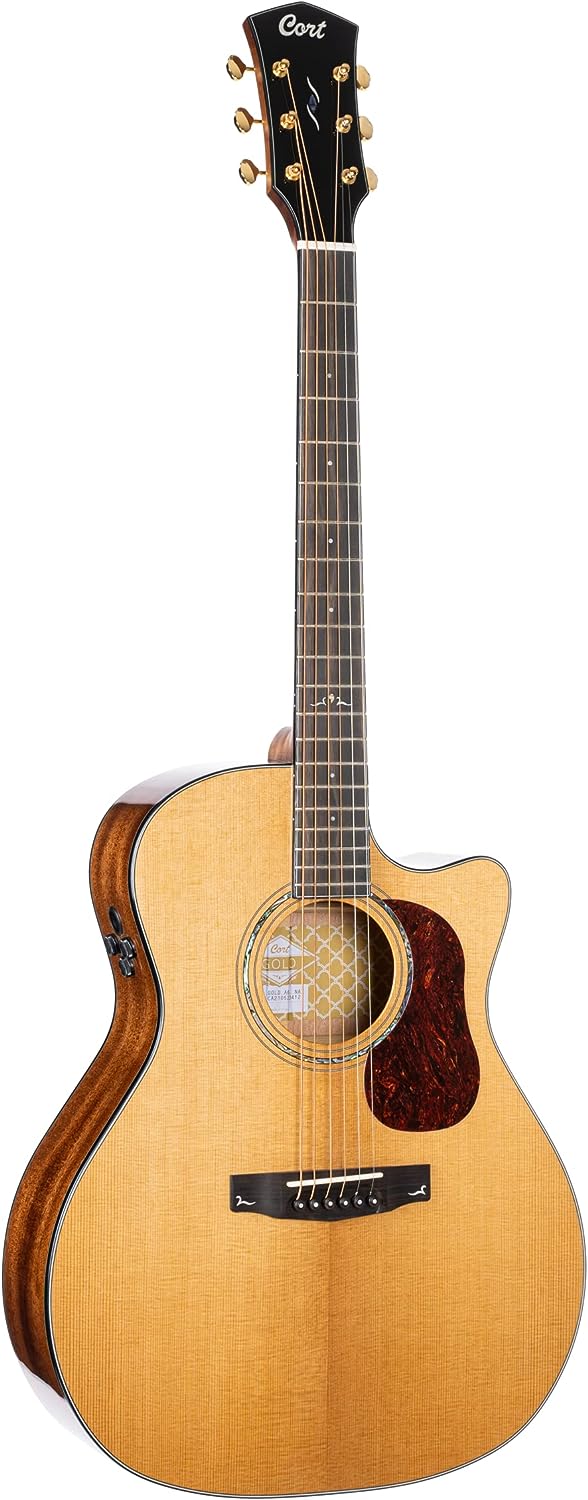
Cort’s Gold A6 NAT guitar offers the perfect balance between the grandeur of a Dreadnought and the intimacy of a Grand Concert, thanks to its unique Auditorium size.
Its measurements of 117mm or 4 5/8″ body depth, an upper bout width of 292mm or 11 1/2″, and a lower bout width of 405mm or 16″ make it perfect for both fingerstyle and flatpicking or strumming.
Along with the guitar, a thoughtfully designed Deluxe Soft-Side Cort case is also provided. Consisting of a blend of a hard case’s protective attributes and a padded gig-bag’s flexibility, it ensures maximum protection while maintaining portability.
The walnut-reinforced neck introduces another layer of stability to the Gold A6 NAT, while preserving the natural characteristics of the wood.
The application of two pieces of walnut bolsters the durability of the Gold.
Featuring a fusion of stylish aesthetics and technical ingenuity, the guitar is fitted with a Flex Blend System.
This system comprises a built-in tuner and various functions, like Volume, Tone, Phase, and Blend, which can be adjusted according to strumming or fingerstyle playing requirements, to deliver optimal natural acoustic sound.
The Cort Gold A6 NAT guitar is made from Torrefied Solid Sitka Spruce on the top, Mahogany for the body, Solid Mahogany at the back, Walnut Reinforced Mahogany for the neck, and Macassar Ebony for the fretboard.
It has a guitar pickup configuration called Flex Blend and uses Bronze for the strings.
The Gold series models by Cort are distinguished by their exclusive Aged to Vintage (ATV) treatment, which gives the Sitka spruce top the same full and open tone that vintage guitars have, right from day one.
It comes with a sonically-enhanced UV finish that protects the instrument and the sound quality.
This model also comes with a new optional Light Burst color, besides the standard Natural Gloss.
- My Review
From the moment I picked up the Gold A6 NAT w/case, I knew I was dealing with something special.
Notably, its dimensions suggest an excellent balance between comfort and performance.
Situated precisely between a larger Dreadnought and a more intimate Grand Concert, the Auditorium body size lends flexibility for a wide range of acoustic styles.
This makes me believe that it is a suitable pick for both strummers/flatpickers and those who lean towards fingerstyle playing, catering to an array of individual playing styles.
I must also comment on the soft-side case that the guitar comes with.
Combining the safety of a hard case with the convenience and flexibility of a gig-bag, I found this to be an excellent addition, offering both security for the instrument and ease of portability.
Another aspect that caught my attention was the neck construction.
Having been reinforced with two pieces of special walnut inserts, it delivers added rigidity and stability without compromising on the natural resonance of the wood.
The Flex Blend System on this guitar stands as a testament to innovation and modern design.
Through volume, tone, phase, blend, and tuner functions all accessible from three knobs, it provides a generous variety of tonal control.
It’s particularly admirable that a built-in tuner is added to its specification, making tuning as effortless as possible.
Additionally, the unique ability to modify the Tone knob to better align with either fingerpicking or strumming styles impressed me, as it aids in reducing feedback issues and other potential sound distortions.
Looking at the materials used, I was pleased to see the Top material to be Torrefied solid Sitka spruce, a choice that definitely contributes to its rich, natural acoustic sound.
Furthermore, the body made from mahogany and a solid mahogany back provide it with a warm and robust midrange tone.
The guitar’s aged-to-vintage (ATV) treatment truly gives it a mature sound profile, featuring a bright yet natural tone that closely mimics those of a vintage guitar.
I found this tone further strengthened by its UV finish that not only conserves the guitar’s visual appeal but also safeguards the tonal quality.
Whether you are a beginner or an experienced musician, I strongly believe that the Gold A6 NAT w/case will serve as an excellent choice, providing value, versatility, and tonal richness in abundance.
- Pros:
- Optimal body size for versatility.
- Included Deluxe Soft-Side Cort Case.
- Innovative Flex Blend System.
- Cons:
- May be too large for some.
- No color variety.
My final verdict is that the Gold A6 NAT w/case is an impressive mid-range guitar suitable for multiple playing styles.
The Auditorium body type is perfect for both strumming/flatpicking and fingerstyle playing.
Its walnut reinforced neck and flex blend system guarantee superior versatility, stability and control of sonic output.
Moreover, the cort deluxe soft-side case and aged to vintage (ATV) treatment stand out as unique features that not only protect this instrument but also contribute towards achieving a mature, vintage tone.
It is a great purchase for both experienced musicians and those keen on upgrading their existing instrument.
Martin D-45 Acoustic Guitar
Flagship Martin guitar with high-performance features.
This high-quality guitar by Martin boasts a natural gloss finish and a range of materials including rosewood and spruce wood. Incorporating features such as sitka spruce scalloped bracing and abalone style 45 hexagon inlays, it’s a go-to for many renowned musicians like Gene Autry and Stephen Stills. The 2018 model includes new forward shifted scalloped X bracing, open gear tuners, an aging toner top finish, and a high performance neck profile.
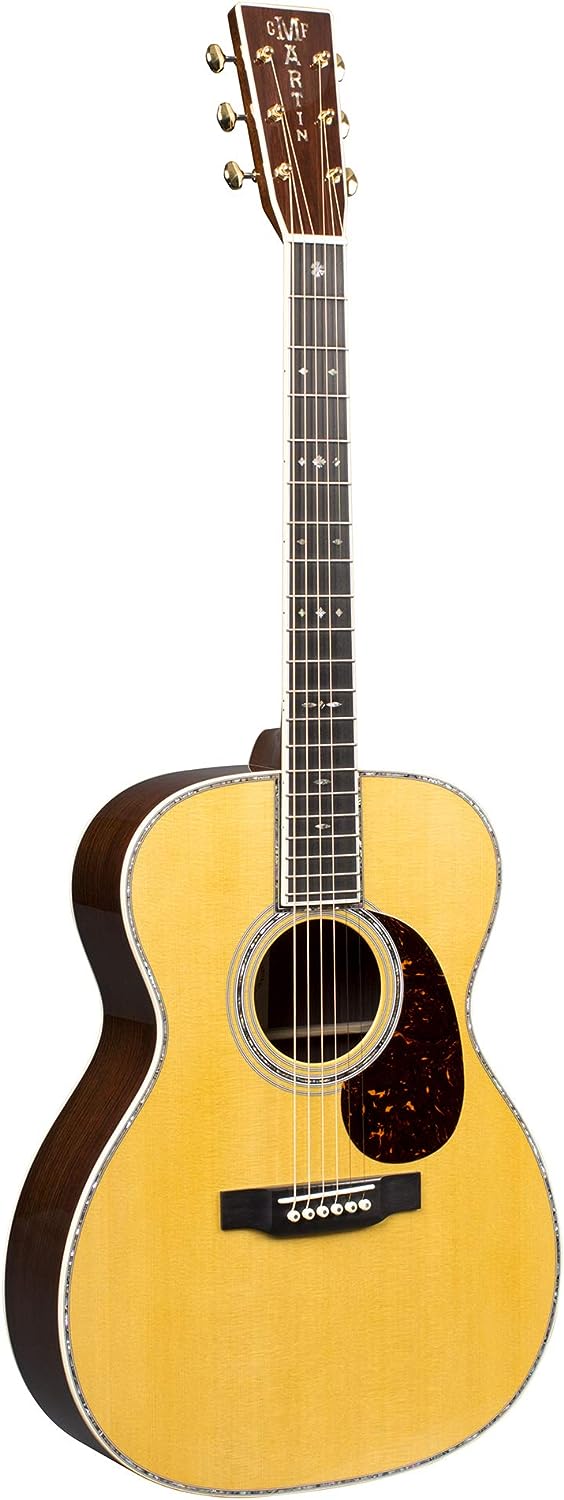
The Martin D-45 Natural is a truly standout dreadnought guitar, brought to you from the brand that pioneered this specific guitar type.
Made with aesthetically pleasing and sonically superior East Indian Rosewood for its body, back and neck, extras such as the spruce top and rosewood fretboard ensures uncompromising sound quality.
Part of what makes this instrument so special is its Hand Orientation specifically designed for right-handed players, making it a versatile choice for many musicians.
This guitar comes with a standard six-string setup and its dimensions clock in at a practical 47″L x 20″W x 9″H.
The design not only impresses with its natural gloss finish over the sitka spruce top but also boasts sophisticated abalone style 45 hexagon inlays.
The intricate structure of the Martin D-45 Natural is emphasized by its scalloped bracing, crafted in the sitka spruce style, which promises an enhanced acoustic output.
A noteworthy feature is the advanced top finish, known as the aging toner, that adds a rich patina to the instrument over time.
Another feature worth mentioning is its open gear tuners which ensures accurate and stable tuning.
- My Review
When I first laid eyes on the Martin D-45 Natural, I immediately appreciated its classic design and glossy finish.
Their use of East Indian rosewood for both the body and back material is aesthetically pleasing and lends the guitar a robust quality.
Indeed, the sitka spruce top combined with the rosewood really highlights the craftsmanship of this guitar.
The D-45 comes fitted with style 45 purfling and hexagon inlays that are quite the show-stealer in terms of visuals.
Building on the aesthetics, I found the balance between the grandeur and functionality very well thought out.
While most wouldn’t imagine rosewood to be the first choice for a fretboard, this model carries it with absolute confidence.
However, let’s not be forgetful of how a guitar sounds – the essence of any guitar lies in its sound quality.
With its spruce and rosewood construction, the D-45 has the ability to produce a wonderful array of sounds, making it highly versatile.
The choice of materials and the quality of craftsmanship shine through in the balanced and resonant tone of this guitar.
Yet, I have to admit I was a bit taken aback when I first tried it out and found it was initially fitted with plastic strings.
In my opinion, steel strings are more suitable for this model, enhancing its tone and overall sound quality.
Worth noting, the D-45 is a bit on the larger side with its dreadnought design, which some might find a little unwieldy and would ideally suit someone with larger hands or long fingers.
Considering the D-45’s high end category, I did find one issue, which is the edge strap falling off which could easily be fixed by a luthier, however, one would not expect such issue in this price range.
Another aspect that one should pay attention to is the buzzing of strings, which seemed to occur after several months.
Such a problem may be encountered with inadequate care and attention, so ensuring proper storage and care is crucial in maintaining the quality for the D-45 or any guitars in general.
While this guitar doesn’t come without its flaws, the overall experience of using the Martin D-45 has been more satisfactory than not.
The quality in sound, materials, and overall workmanship are never to be overlooked and can easily outshine some minor quirks.
The Martin D-45 is indeed a hefty investment, but for those who are passionate about sound quality and design, this is an instrument that could truly inspire and bring joy.
- Pros:
- Maximum resonance and projection.
- Superior craftsmanship.
- Luxurious styling with abalone inlays.
- Cons:
- May have issue with string buzzing.
- Potential issue with peeling.
- Tends not retain its value.
My final verdict is that the Martin D-45 Natural is a dreadnought that lives up to the Martin reputation.
The rich choice of materials, especially the extensive use of rosewood, contributes significantly to the exceptional sound and look of this instrument.
The updated features introduced in the 2018 Standard Series, such as the forward shifted scalloped X bracing, provide improvements in sound quality.
The Martin D-45 is undoubtedly a top-tier instrument ideal for professional musicians and serious amateur players looking for a high-end dreadnought.
Worth the investment for those who appreciate fine guitars.
Ovation CE44-5 Acoustic-Electric Guitar
Superior sound, elegant design, remarkable note clarity.
The Ovation CE44-5 offers a classic mid-depth Lyrachord cutaway body with a solid spruce top which creates clear highs and a balanced bass response. It incorporates new scalloped “X” bracing for optimal response and power, as well as an Ovation Slim line pickup and OP-4BT preamp system for a great live sound. Complete with a beautiful gloss black finish, the instrument resonates with full projection, and nuanced tonal complexity.
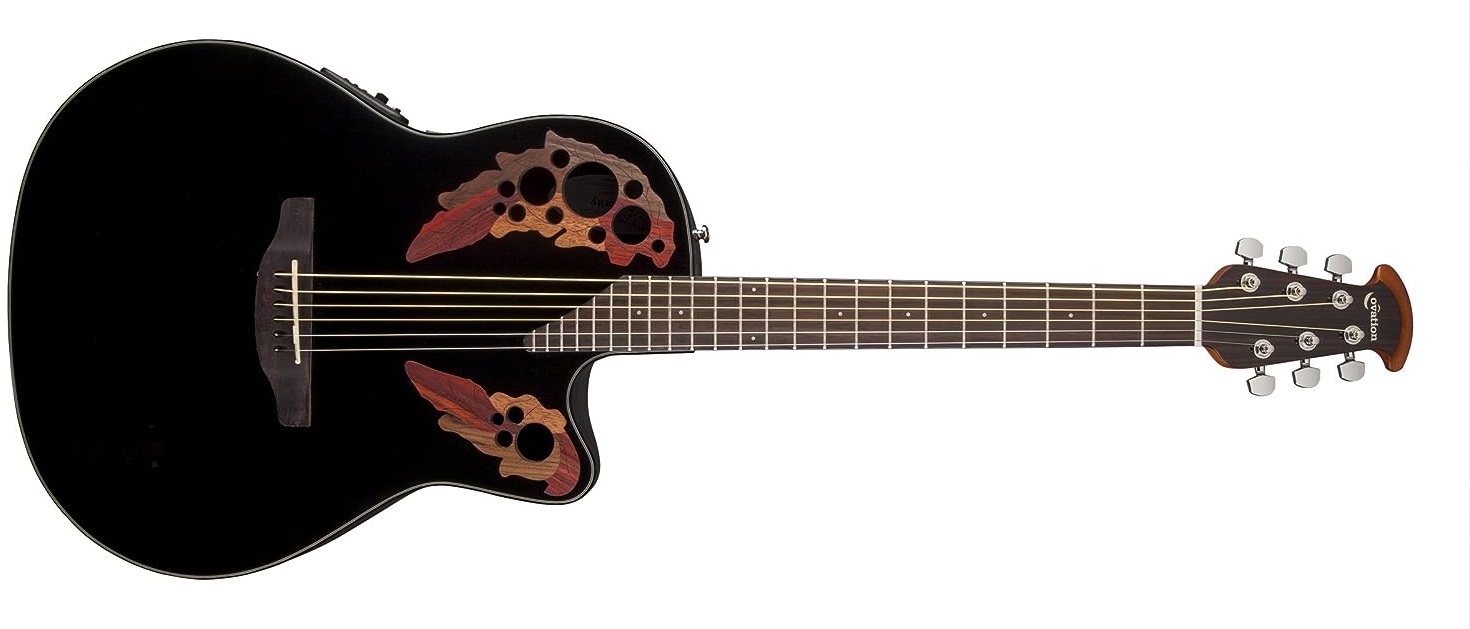
The Ovation CE44-5 Acoustic-Electric Guitar, presented in striking black, is a beautifully designed instrument that mirrors the classic Ovation Elite series.
With its traditional mid-depth Lyrachord cutaway body and solid spruce top, this guitar is built to provide clear highs and balanced bass
Unique to this model is its scalloped “X” bracing design that captures elements from earlier designs and adapts them to fit modern needs.
Combined with the body and top, this innovative structure promotes optimal tone, response, and power.
This guitar also boasts multi-soundhole architecture, encompassing multiple sound holes that work together to enhance note clarity and project a full, balanced sound.
To further embellish its exterior, it’s wrapped with black binding and multi-wood epaulets for a rich, elegant finish.
The guitar also features an efficient Ovation Slimline pickup and OP-4BT preamp system that come with a three-band equalizer and volume/gain control to provide robust live sound.
This system also includes an onboard tuner and low-battery light.
Constructed with quality materials, from its spruce top and fiberglass body to a rosewood fretboard, it signifies Ovation’s commitment to excellence.
This particular model is designed for those who are right-handed and uses bronze strings with a fixed guitar bridge system.
- My Review
Let me start by saying that I was thoroughly impressed with the Ovation CE44-5 Acoustic-Electric Guitar.
It’s meticulously crafted with a mid-depth Lyrachord cutaway body and a solid spruce top, a combo that delivers high-quality sound.
One standout feature is the guitar’s unique Elite multi sound hole design, which provides clear highs and a focused, well-rounded bass response.
The instrument’s innovative scalloped ‘X’ bracing design is blended from the past yet voiced for the present, consistently delivering natural but powerful tones.
Alongside convenience, the guitar features an Ovation Slim line pickup and OP-4BT preamp system that accommodates an onboard tuner and low-battery light.
This clever configuration delivers a great live sound, making the product highly practical for live performers.
What’s more, it pleases me to say that the guitar’s appearance is as remarkable as its sound, with elegant multi-wood epaulets, black binding, and a glossy finish complementing it.
Please also note that this guitar’s primary construction materials—spruce, fiberglass, and rosewood—are excellent choices for ensuring durability and premium sound quality.
On a more critical note, the guitar’s notable sound does come with a few drawbacks.
I did find the fret buzz on the bass side from the first to about the 5th fret mildly noticeable and disconcerting.
Some mild adjustments were necessary to eliminate it, which resulted in the bass side of the neck action being a tad higher than I usually prefer.
I also find, particularly when amplified, that there’s a more significant difference in sound between this multi-soundhole design and a traditional center-hole type.
I would argue that it lacks a certain full range, but, in fairness, this may come down to personal preference.
The packaging it arrived in was not as sturdy as I would’ve liked it to be, giving me some concerns about the overall handling and delivery process.
Furthermore, the fact that the guitar doesn’t come with a warranty was somewhat disappointing, as it doesn’t provide the purchaser with the assurance regarding potential defects or faults.
However, despite these minor caveats, the instrument’s overall performance, sound, and quality easily surpass its minor drawbacks.
It’s a remarkable guitar that provides both style and first-rate sound, making it a good investment, especially for those seeking an upgrade or, even beginners wanting to take their skills to the next level.
- Pros:
- High quality, powerful sound
- Unique soundhole design
- Comfortable, easy to play neck
- Cons:
- Potential fret buzz Issue
- Difficulties with sound for small hole type
- Quality control can be inconsistent
My final verdict is that the Ovation CE44-5 Acoustic-Electric Guitar, Black holds its own in the market, offering some excellent features that appeal to both beginners and professionals.
This guitar offers a perfect blend of aesthetics with its black gloss finish, functionality with its mid-depth cutaway body and solid spruce top and most importantly, impressive sound quality with its unique Elite multi soundhole design.
It comes with a user-friendly OP-4BT preamp system that is perfect for live performances and the added advantage of a built-in tuner and low-battery light for convenience.
Despite its relatively high price, the value for money and carefully thought out features make the Ovation CE44-5 a worthwhile investment for any music lover.
Blueridge BR-160 Historic Series Acoustic Guitar
Distinct vintage look with powerful, crisp tone.
Featuring a solid Sitka spruce top and Indian rosewood back and sides, this guitar delivers a clean, crisp tone with deep bass. The slim mahogany neck offers easy action and stability, coupled with a smooth rosewood fingerboard. Rounding up with vintage style appointments, it combines aesthetics with high-performance to create a desirable vintage-style acoustic instrument.
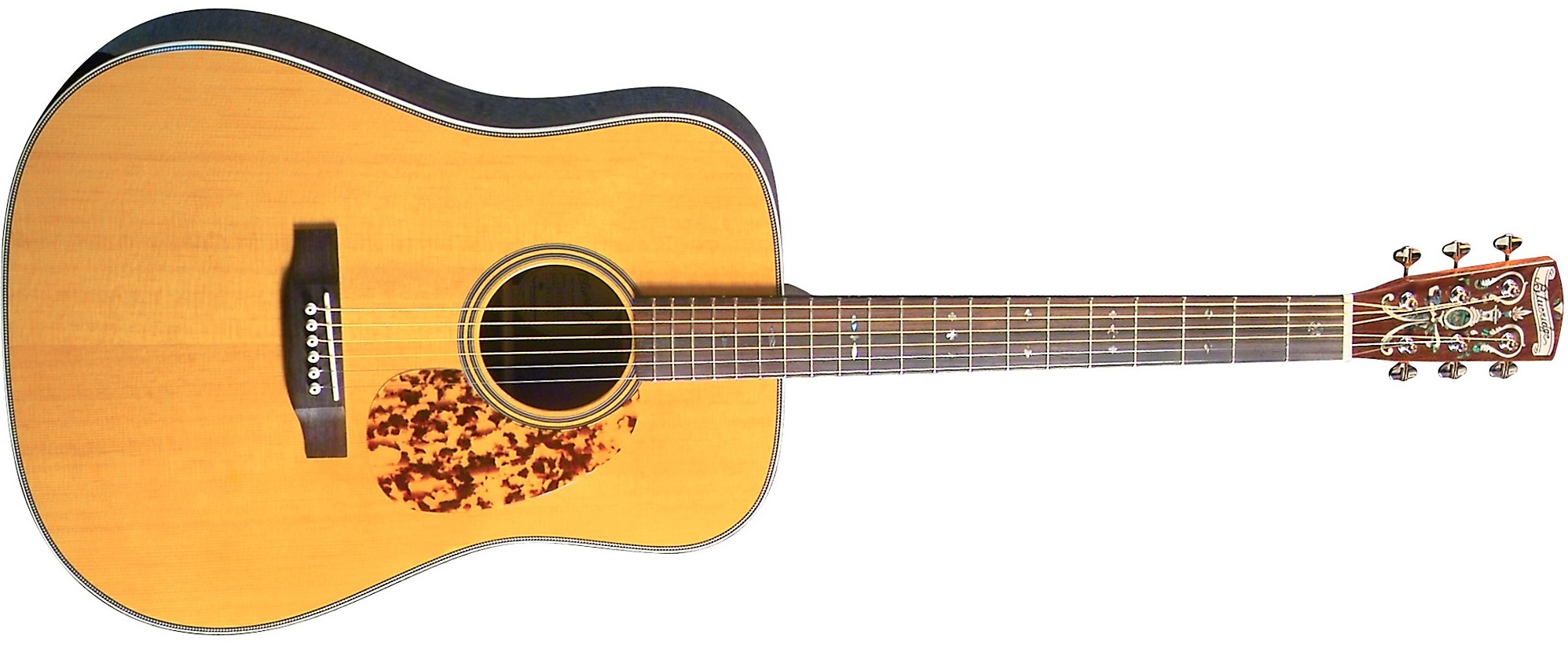
The Blueridge BR-160 Historic Series Dreadnought Guitar has been crafted with precision for sound quality as well as looks.
Its top part is made of Solid Sitka spruce with specially designed scalloped braces, which are known to produce a distinct, crisp tone with clear articulation.
To ensure strong bass and spectacular cutting power, the back and sides of the guitar are made from solid Indian rosewood.
The guitar features a slim mahogany neck, which not only assures swift, fluid action but also offers long-lasting stability inherently.
You will experience a silky smooth playability, thanks to the choice East Indian rosewood fingerboard.
Inspired by the vintage style of the 30’s, the distinctive tortoise style pickguard further enhances the guitar’s visual appeal.
As a creation from Blueridge Guitars, it reflects a charming yellow hue, made from premium quality Spruce wood and East India Rosewood for the body materials.
The additional combination of mahogany for the neck material, rosewood for the fretboard and phosphor bronze strings, ensures a sound profile that is hard to resist.
Designed for right-hand orientation, it incorporates a rosewood bridge system, tailored to optimize the overall guitar playing experience.
Inspired by a prewar Herringbone design, the BR-160 boasts a vintage appeal, while its hand-carved parabolic top braces and dovetail neck joint complement the instrument’s durability and performance.
The guitar’s aesthetics are nicely rounded off with a Dalmatian tortoise style pickguard and mother-of-pearl inlays on the neck and headstock.
- My Review
Upon first laying my hands on the Blueridge BR-160 Historic Series Dreadnought Guitar, I was immediately drawn by the vibrancy of its yellow color
Admittedly, the guitar itself is a sight to behold, with a body boasting top-quality spruce wood and East India rosewood back and sides.
Not just about looks, the instrument offers a loud and crisp tone owing to its solid Sitka spruce top fused with scalloped braces.
To complement the already marvelous audio output, its solid Indian rosewood back and sides ensure deep bass and unquestionably powerful cutting prowess.
Another delight is its slim mahogany neck which allows for fast and easy action.
This, combined with its long-lasting stability, makes playing this guitar an exquisite experience.
Additionally, the East Indian rosewood fingerboard ensures smooth playability, enhancing the guitar’s overall performance.
Among the guitar’s features that impressed me was how it efficiently recreates a vintage look with its distinctive tortoise-style pickguard.
One downside I observed was a missing strap button on the heel, but this doesn’t compromise its overall performance.
However, the craftsmanship of this guitar is truly exceptional, as its prewar-inspired herringbone dreadnought contains a solid Sitka spruce top and hand-carved parabolic top braces, honoring the prewar forward x-pattern.
Additionally, I noticed that it comes with Indian rosewood back and sides that add a strong bass to the spruce top’s already robust sound.
Its slim mahogany neck adds a convenient touch that doesn’t compromise the quality of the guitar’s sound or look.
To list some faults, the guitar does come from China, and this could raise concerns about durability.
It is essential to point out that despite this potential flaw, the guitar, at least in my hands, has shown no evidence of shoddy craftsmanship or cheap materials.
My experience with the Blueridge BR-160 Historic Series Dreadnought Guitar has been a fulfilling one.
It provides beautiful tones, a wonderful playability, and a dashing look that would attract any guitar enthusiast.
With its flaws being few and far between, it’s definitely a guitar worth considering.
- Pros:
- Great sound and tone quality.
- Beautiful, vintage construction.
- Stable and fast-action neck.
- Cons:
- Potential shipping damage.
- Originating from China may discourage some.
My final verdict is that the Blueridge BR-160 Historic Series Dreadnought Guitar is simply exceptional.
The Solid Sitka spruce top delivers a clean and crisp tone, supported well by the deep bass from the Indian rosewood back and sides.
With a slim mahogany neck that is both comfortable and durable, and an East Indian rosewood fingerboard for smooth playability, it really stands out in its category.
The aesthetics, particularly the distinctive tortoise style pickguard and the prewar design, give it a vintage charm that is hard to resist.
Considering all its features, the Blueridge BR-160 offers both great sound and great looks, making it highly recommendable for any guitar enthusiast.
Epiphone Masterbilt Excellente Acoustic-Electric Guitar
Iconic acoustic guitar with exceptional sound quality.
This guitar, crafted with an Ovangkol wood back, a mahogany neck, and ebony wood fretboard, boasts 20 medium jumbo frets along with a 1.68″ bone nut. It features a sophisticated on-board preamp system for superior acoustic sound quality. Its design replicates the iconic 1960s Masterbilt Excellente, a favorite of country superstar Loretta Lynn.
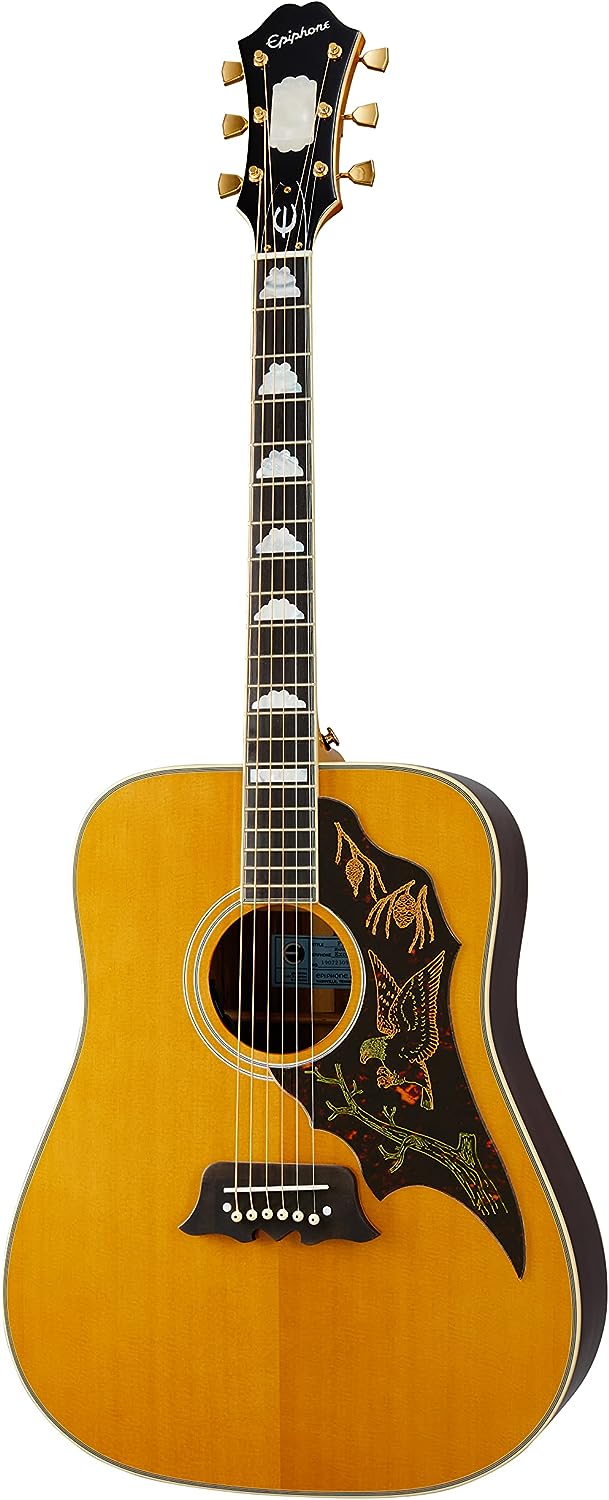
This Epiphone Masterbilt Excellente offers both acoustic and electric capabilities, and charms with an antique natural aged finish.
Epiphone’s classic hardware decorate this guitar, rendering a solid and reliable playing experience.
The 25.5” scale length aligns perfectly with its 20 medium jumbo frets for optimal playability.
Guitarists will find the 12” radius and 1.68” bone nut components comfortable and advantageous for their performances.
The stylish color palette includes variations of brown, gold, burgundy, and black.
Each of these colors superbly highlights the ovangkol wood used for the back material type and the ebony wood fretboard.
The right-handed orientation, mahogany neck, and six strings complement the guitar’s overall design.
With product dimensions of 43.5″L x 20.79″W x 8.62″H, this handy-size guitar is relatively easy to transport.
Resurrecting the iconic acoustic designs of the ‘golden era’, this guitar boasts an updated version of the dreadnought style commonly associated with country star, Loretta Lynn.
Solid Sitka Spruce forms the top surface, harmonizing with the Ovangkol body to produce rich and resonant tones.
The fingerboard is adorned with the characteristic “Cloud” inlays to maintain the historic vibe.
One crucial attribute is the integration of the advanced Fishman Sonitone Onboard Preamp System, allowing players to effortlessly achieve authentic acoustic tones in any setting.
- My Review
Let’s delve into a detailed review of the Epiphone Masterbilt Excellente Acoustic Electric Guitar.
One aspect that instantly stood out during my experience with this instrument was the sheer quality of the materials used in its construction.
The use of Mahogany for the neck and Ovangkol wood for the back, plus an Ebony wood fretboard, quite evidently contributes to its robustness and durability.
Complementing its sturdy build, is the antique natural aged colored finish, offering an attractive blend of brown, gold, burgundy, and black that undeniably enhances the guitar’s aesthetic appeal.
Playing the Masterbilt Excellente, I found the fretboard to be comfortable and the hand orientation favorable for right-handed musicians like myself.
The inclusion of 20 medium jumbo frets gives plenty of room for musical exploration, further reinforced by a practical 25.5″ scale length.
Shaping the tone and resonance of this guitar is the Solid Sitka Spruce top.
Equally impressive is the historic “Cloud” inlays on the ebony fingerboard that provide a nostalgic vibe reminiscent of iconic acoustic guitars from previously popular eras.
What truly differentiates this instrument from other models, is the integration of the Fishman Sonitone Onboard Preamp System.
This innovative feature ensures that you can capture the guitar’s authentic acoustic tone and relay it on any stage confidently.
Having said this, it is only fair to address a few critical observations I noticed during my time with the Epiphone Masterbilt Excellente.
It seems, as beautiful and stylish as this guitar is, there might be a few manufacturing inconsistencies that are worrisome.
Issues such as the bridge alignment and the condition of the frets not quite matched up to the quality I initially anticipated.
These lapses could derive from the manufacturing process and may impact the instrument’s playability and user experience.
Nonetheless, despite these minor setbacks, my overall experience with the Epiphone Masterbilt Excellente Acoustic Electric Guitar was largely positive.
Its captivating vintage design, coupled with a magnificent sound, managed to overshadow the manufacturing imperfections.
With Epiphone’s years of experience reflected in its features and quality, this guitar is definitely a noteworthy choice for passionate, forward-thinking musicians.
It blends the magic of past designs with modern technology, resulting in a true gift for any aspiring or professional musician.
- Pros:
- Great sound quality.
- Historically accurate design.
- High-quality materials used.
- Cons:
- Reported factory defects.
- High and uneven frets.
- Possible misaligned bridge.
My final verdict is that the Epiphone Masterbilt Excellente Acoustic Electric Guitar truly lives up to its name as an ‘excellente’ instrument.
It delivers in both appearance and sound, with a remarkable range of colors and a tone that comfortably fits into the professional grade.
The inclusion of a Fishman Sonitone Onboard Preamp System means it is totally gig-ready, even in larger venues.
And with its old-world Masterbilt techniques and materials like Solid Sitka Spruce top and Ovangkol body, it is a nod to the rich history of Epiphone acoustics.
This is a fantastic, professional-quality guitar that is worth every penny.
Epiphone J45 Acoustic-Electric Guitar
High-quality materials with Fishman Sonicore pickups.
The guitar, in a striking Vintage Sunburst color, has a spruce top and mahogany body and neck, incorporating a Laurel Wood fretboard for a warm tone. It’s outfitted with a Fishman Sonicore pickup configuration, ensuring high-quality amplification across a range of acoustic settings. The Nickel strings provide a clear sound, making it a perfect fit for right-handed players.
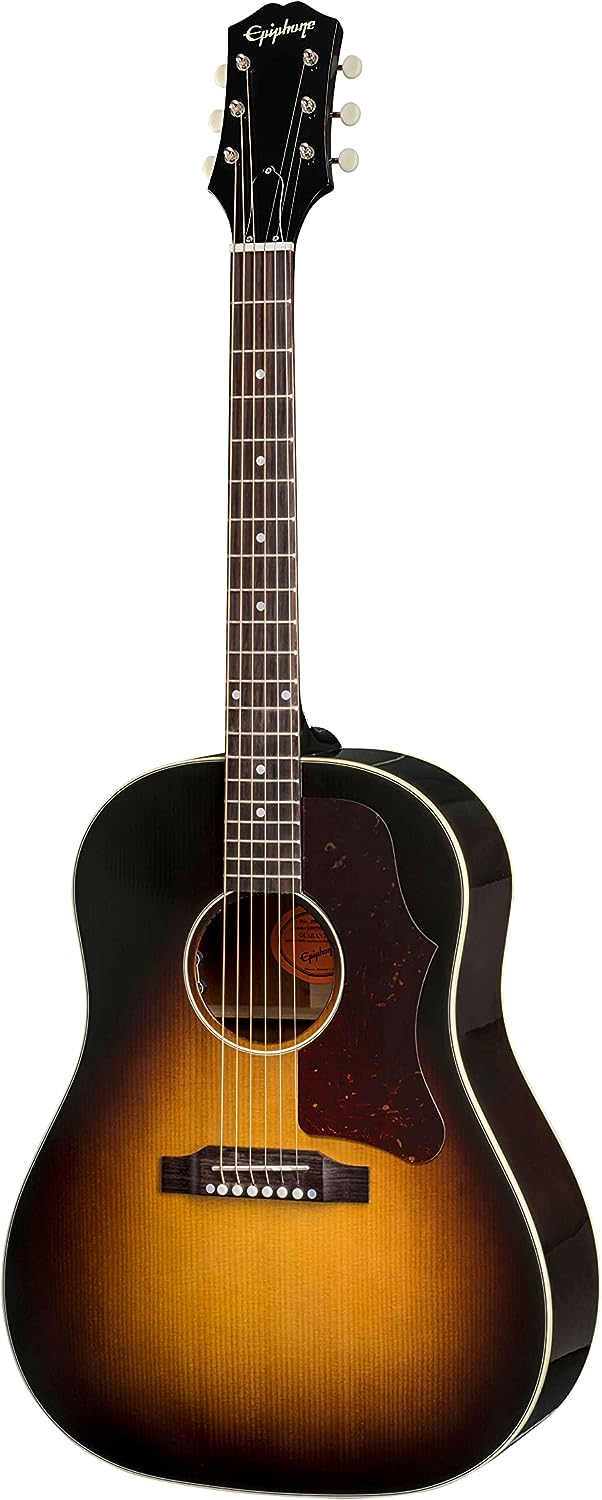
The Epiphone J45 is not your everyday acoustic guitar as it comes equipped with electric capabilities. Its design mimics that of a sloped-shouldered dreadnought, which is particularly suitable for performers who demand a robust sound.
This guitar will catch your eye with its Vintage Sunburst finish that adds a touch of nostalgia and classic elegance to its overall appearance.
Being made by Epiphone, a reputed brand in the guitar industry, guarantees its exceptional build quality and superior sound resonance.
The guitar features a Spruce top, known for its versatility and ability to produce a broad range of tones. Its body and neck are built from Mahogany, a choice wood for its resonance and durability.
Complementing the body and neck, the fretboard is of Laurel wood, preferred by many guitarists for its smooth feel and playability.
This acoustic electric guitar sports a Fishman Sonicore pickup configuration which amplifies and augments the natural acoustic sound without introducing any distortion.
The string material used is Nickel, known for its bright and clear tone, suited for a wide variety of music genre.
Finally, it is important to mention that this guitar is designed for Right-handed guitarists which is the more common variant.
The Epiphone J45 Acoustic Electric Guitar is a nicely crafted instrument, combining traditional materials with modern electronics for an impressive musical performance.
- My Review
Upon laying my hands on the Epiphone J45 Acoustic Electric Guitar, I was struck by the visually appealing Vintage Sunburst color, lending a classic touch to the instrument.
Gazing at the crafted mahogany body and spruce top material, the craftsmanship and quality is undeniable and immediately evident.
It boasts a laurel wood fretboard which feels both soft and balanced for the fingers, this certainly adds to the overall playing experience.
I also noticed that this guitar is equipped with a Fishman Sonicore pickup configuration, enhancing the tonal qualities and lending ample volume for live performances.
To give it a whirl, I adjusted my hand positioning to a right-hand orientation and began to play a few chords.
All was going well until I noticed a somewhat lighter, less substantial tone, a characteristic that might be synonymous with Epiphone’s built.
Its sound comes off more crisp and twangy, which some might find desirable, though it lacks the deep warmth of a traditional Gibson guitar.
While the slight heaviness might seem a setback to some players, it didn’t bother me as much and its solidly built structure seems to compensate for this minor trade-off.
On the other hand, when discussing price points, this Epiphones J45 might appear as a more feasible option for those who entertain the dream of owning a Gibson but are budget constrained.
It’s important to reiterate, however, that desires for sound quality should not be compromised and hence, it might be prudent to explore alternatives such as entry Martins and certain Yamahas.
One can find these guitars producing a sound treasure that squarely encases the price bracket of the J45 and creating a comparable if not more satisfying audio experience.
It’s also essential to note, guitars being the individualistic instruments that they are, not all Epiphone J45’s might sound the same.
When picking your instrument, it would be wise to play a few different ones before making the purchase.
The Epiphone J45 Acoustic Electric Guitar does bear some noteworthy features and quality parts that make it an admirable choice for a certain group of players, despite its minor sound discrepancies.
- Pros:
- Stunning Vintage Sunburst color.
- Quality Mahogany and Spruce materials.
- Fishman Sonicore Pickup Configuration.
- Cons:
- Sound might feel tinny and buzzy.
- Some may prefer more warmth.
- Potential quality variations.
My final verdict is that the Epiphone J45 Acoustic Electric Guitar is a remarkable instrument.
Its top-notch quality materials like spruce, mahogany, and laurel wood contribute to a rich and resonating sound.
Additionally, the Fishman Sonicore pickup configuration offers exceptional amplification capabilities.
The vintage sunburst color not only adds to its aesthetic value but also gives it a classic touch.
Therefore, I strongly recommend this guitar to all enthusiastic players and musicians seeking a performance-ready instrument with perfect sound and design.
Seagull S6 Original Acoustic Guitar
North American made, unique tone, easy tuning.
This North American-made guitar pairs a solid cedar top with wild cherry back and sides, lending a unique tone that blends mahogany’s warmth with maple’s crisp definition. It boasts a silverleaf maple neck on a shorter 24.84″ scale and a rosewood fretboard and bridge for ease of play. Further features include a double-action truss rod, tapered headstock, precise tuning, and Tusq nut and compensated saddle for better intonation.
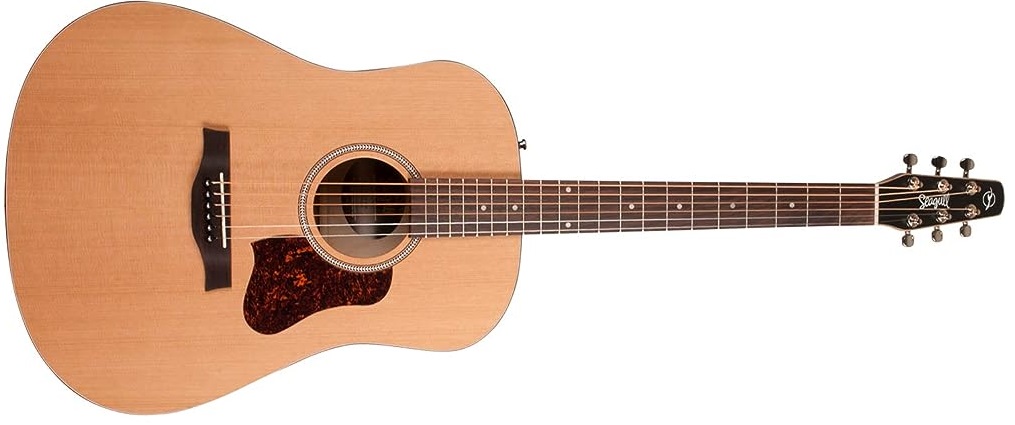
The Seagull S6 Original acoustic guitar is an excellent instrument, crafted with meticulous attention to detail.
Constructed in North America, it stands testament to the quality associated with the region’s principles.
One of its many notable features includes a double action truss rod, ensuring structural integrity and relief adjustments.
The tapered headstock design not only enhances its visual appeal, but also makes way for amazing open tunings and precise, stable tuning capabilities.
Moreover, with the tusq nut and compensated saddle, the guitar ensures better intonation.
Seagull has made this guitar in a gorgeous natural color, using a plethora of quality materials.
The top of the guitar is made from cedar, finely selected and pressure tested for optimum resonance.
The main body is composed of wild cherry and cedar, a unique combination offering the warmth of mahogany with the crisp definition of maple.
The fretboard is made of rosewood which enhances playability.
Additionally, the strings are made of phosphor bronze, giving a more refined sound.
They have also been careful to consider right-handed players as indicated by the right hand orientation design.
The bridge system boasts high-quality rosewood, ensuring robust, dynamic tonality.
The shiny semi-gloss lacquer finish is the cherry on top, making the S6 not only sound fantastic but also look marvelous.
- My Review
Upon playing the Seagull S6 Original Acoustic Guitar, the first thing that struck me was its exceptional sound quality.
The instrument successfully marries the warmth of mahogany with the clear articulation of maple, resulting in a rich and unique blend of tones.
The pressure-tested cedar top and rosewood bridge system seem to further enhance the sonic qualities, yielding an enjoyable playing experience.
Notwithstanding the sound, the build quality is equally commendable.
This acoustic guitar stands out with its cherry back and sides, providing a unique look.
The silverleaf maple neck is welcomingly comfortable, especially when tackling more complex chord structures.
Yet, the width of the nutfretboard is something to take into consideration – some may find it not wide enough, particularly if you have larger fingers.
I also noticed that the guitar tends to need a bit more frequent tuning than some other models.
However, that could also be down to individual playing style, and thus not necessarily a deal-breaker.
One conceivable issue is with the seller not consistently supplying the correct model – differentiating between the original and ‘slim’ version might not be clearly indicated, which could lead to an unsuitable choice.
This could cause some frustration, particularly for those who prefer a wider nut, and are unwittingly sent a slim version instead.
Despite its small missteps, the Seagull S6 is a pleasure to play and an undoubtedly well-crafted instrument.
Its double action truss rod and tapered headstock attribute to its durability and overall playing comfort.
Even though the S6 is not the cheapest on the market, its performance and stylish aesthetics, for me, justified its price tag.
When it comes to the brand, one can sense the pride and care Seagull has put into creating this acoustic guitar – from the choice of high-quality materials to the fine details of the finish.
The semi-gloss lacquer finish gives the instrument a premium feel, while the overall build is appealing, indeed, making the S6 a worthy addition to any musicians’ collection.
- Pros:
- Excellent sound quality.
- Beautiful craftsmanship.
- Comfortable to play.
- Cons:
- Inconsistent performance reported.
- Narrow nut/fretboard space.
- Finish may be easily scratched.
My final verdict is that the Seagull S6 Original Acoustic Guitar is an exceptional instrument.
With its domestic wild cherry back and sides and solid cedar top, this guitar offers a balance of warmth and crisp definition that is truly unique.
The shorter scale, rosewood fretboard, and specially aligned machine heads not only make it easy on the fingers but also ensure quick, stable tuning.
Moreover, it is made in North America, ensuring high quality and durability.
This guitar is well worth the investment for both beginner and experienced guitarists alike.
Fender American Acoustasonic Telecaster Guitar
Revolutionary guitar with distinct acoustic-electric tones.
This guitar is a cutting-edge acoustic-electric hybrid from Fender, boasting an innovative acoustic shape-shifting feature and five distinctive voice pairs. Crafted with a spruce wood top, mahogany body and neck, and ebony fingerboard; it comes with a gig bag for easy transportation. Harnessing the power of Fender and Fishman’s Acoustic Engine, it delivers an impressive range of tones for versatile performance.

Meet the Fender American Acoustasonic Telecaster, an innovative and versatile acoustic-electric guitar that offers a variety of sounds and tones.
This impressive instrument is capable of shape-shifting its acoustic nature and delivering electric rhythm tones on demand.
Equipped with 5 distinct voice pairs, this Telecaster provides a well-curated array of both acoustic and electric voices, presenting the player with multiple sound options.
The guitar features a forearm and back contour and a comfortable mahogany modern “Deep C” neck.
This guitar is not just about the sound, but also the quality of materials used.
The Fender American Acoustasonic Telecaster boasts a sunburst color and has a sturdy mahogany body.
The top is made of spruce wood while it has a backing made of mahogany as well for added durability.
Adding to the guitar’s richness is its ebony wood fingerboard and its neck made of mahogany.
It uses a unique guitar pickup configuration, namely N4 Magnetic; Fishman Under-Saddle Transducer; Fishman Acoustasonic Enhancer.
Furthermore, the guitar utilises Phosphor Bronze string material and is oriented for right-hand players.
Conceptualized by Fender and Fishman, the Acoustasonic Telecaster is designed with a revolutionary Acoustic Engine that allows it to produce new sonic expressions on stage or in the studio.
- My Review
As an avid guitar enthusiast, I was intrigued by the idea of the Fender American Acoustasonic Telecaster Acoustic Electric Guitar.
Upon the first touch and strum, what set this instrument apart from others was its cutting-edge acoustic-electric capabilities, offering multifaceted tones and sounds.
Impressive versatility became apparent when I flipped through its five distinct, curated voice pairs, gracefully blending acoustic and electric voices.
Flexing the limits of tradition, the bold acoustic shape-shifting offered a revolutionary encounter with unexpected, yet fulfilling electric rhythm tones.
This Fender masterpiece proved that innovation has a place in music, making it an ideal choice for guitarists keen on expanding their musical range.
With a body crafted of mahogany, it features an integrated forearm and back contour, and a modern “Deep C” neck offering an unmatched feel whilst playing.
Visually, the sunburst color and ebony fingerboard added a touch of elegance to the design.
Moreover, equipped with the Fender and Fishman-designed Acoustic Engine, the guitar considerably elevated my sonic expressions during studio sessions as well as live performances.
One issue I encountered while playing, much to my astonishment, was the high E string popping out of the nut, a problem seemingly amendable with a Telecaster string guide.
Though an annoyance, I found it to be a minor inconvenience given the instrument’s overall performance and quality.
The guitar’s lighter weight was a welcome feature too, as it eased the burden during prolonged play sessions.
However, like all great things, this guitar also had its downside where the simulated sounds failed to replicate the depth and richness one would get from the original guitars.
The thought process behind the design is commendable, but what lacked was the authenticity and soulful resonance that classic dreadnoughts or Telecasters offer individually.
While some may argue about it feeling plastic and not ‘wooden’, I think this correlates more with personal preference and the feel one seeks in a guitar.
I had to admit, though, the pricing did feel steep, potentially making this a considered purchase.
In spite of a few minor grievances, one cannot overlook the forward-thinking demeanor of this acoustic-electric hybrid that challenges conventional guitar boundaries.
Bearing the prestigious Fender name, it is indeed a daring venture into the future of stringed instruments.
However, I must respectfully stress that its actual value may be heavily reliant on personal playing preferences and the intended use.
My advice to potential purchasers would be to delve into a deep playing session prior to the acquisition, as its unique characteristics set it apart from conventional expectations of a guitar.
- Pros:
- Highly versatile and multifunctional.
- Lightweight and easy to handle.
- Exceptional acoustic-electric sound quality.
- Cons:
- Some issues with high E string.
- Felt plastic-like to some users.
- Expensive for some customers.
My final verdict is that the Fender American Acoustasonic Telecaster delivers an impressive blend of acoustic and electric tones thanks to its innovative design.
This guitar, with its offering of 5 distinct voice pairs, enables a broad range of sonic expression ideal for both studio and stage performances.
The use of premium materials like Spruce wood, Mahogany and Ebony not only ensure durability but also lend a luxuriant aesthetic appeal to the guitar.
Although it has a premium price tag, its cutting-edge features and quality make it worth the investment for serious guitarists.
The Acoustasonic Telecaster stands as testament to Fender’s long legacy of purposeful innovation in guitar manufacturing.
Takamine GD93CE-NAT Dreadnought Acoustic-Electric Guitar
High-quality versatile sound with upscale feel.
The guitar boasts a solid spruce top, rosewood sides, and a three-piece rosewood/quilt maple back, offering a unique sound and upscale feel. It features a slim mahogany neck, 12″-radius bound rosewood fingerboard, and an onboard Takamine TK-40D preamp system for versatility and quality sound. Completed with maple body binding, a synthetic bone nut, split bridge saddle, and a natural gloss finish, it provides stage-worthy aesthetics.
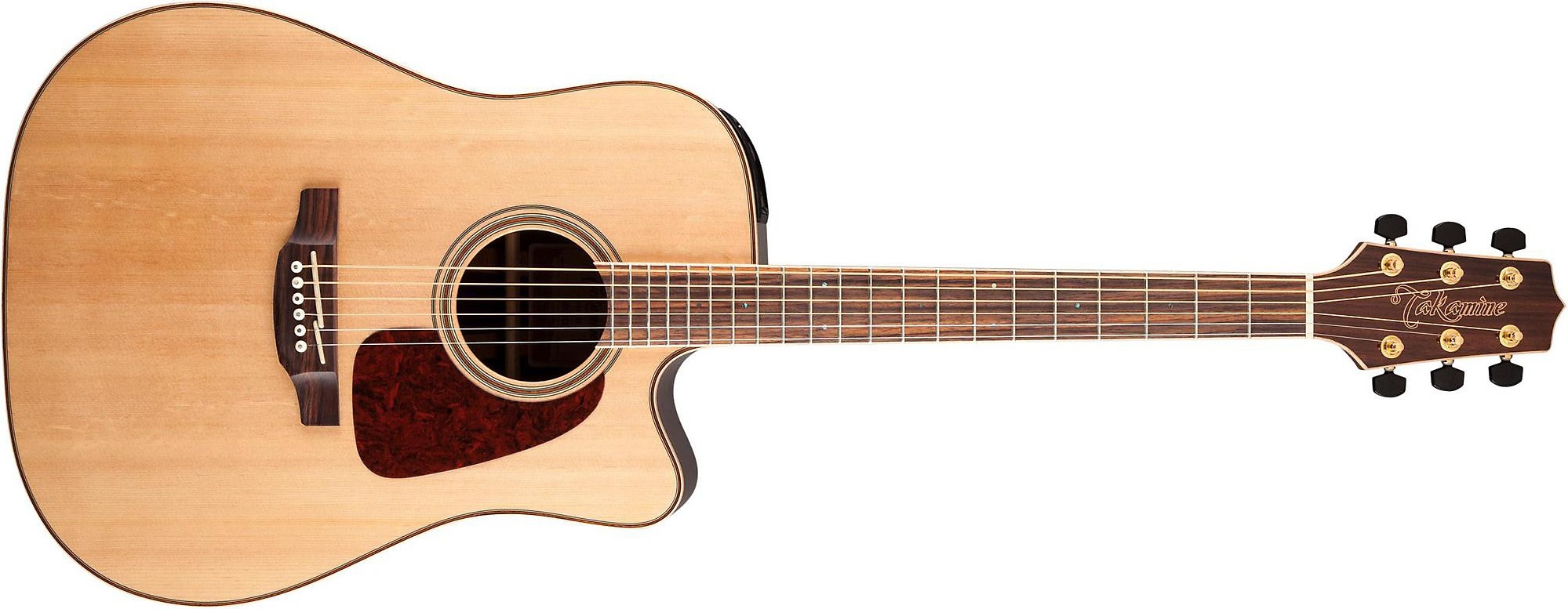
The Takamine GD93CE-NAT Dreadnought Cutaway Acoustic-Electric Guitar is made with an elegant natural color, featuring top-quality materials.
It sports a solid spruce top, combined with rosewood sides, adding to the high-end feel and delivering a distinctive sound.
A standout feature is its three-piece back, beautifully crafted from rosewood and quilt maple, exemplifying the guitar’s refined look.
Designed for comfort and easy playing, there’s a slim mahogany neck and a 12″-radius rosewood fingerboard that’s bound.
The guitar is equipped with Takamine’s TK-40D preamp system, complete with a built-in tuner and several controls for EQ and gain.
Additional notable features include a mid contour switch, along with a notch filter and an EQ bypass switch, all contributing to its sound versatility and quality.
Adding to the aesthetic allure, there’s a maple binding on the body, neck, and headstock.
An attractive natural gloss finish, synthetic bone nut, and a split bridge saddle are among other premium features of this right-hand orientation guitar.
The guitar’s pick-up configuration is piezoelectric, with the string material type being coated phosphor bronze.
Indeed, for those seeking stage-worthy features in an acoustic/electric dreadnought guitar, the Takamine GD93CE-NAT is a standout choice.
- My Review
Having experienced the Takamine GD93CE-NAT Dreadnought Cutaway Acoustic-Electric Guitar first-hand, I can say that its charm is not only on the surface.
Indeed, its elegant natural gloss finish is dazzling, with the rosewood sides and the three-piece rosewood/quilt maple back upping the aesthetic game.
However, more than just a pretty face, this guitar delivers on functionality too.
The solid spruce top contributes immensely to the excellent sound projection and this is complemented beautifully by the construction of the wood body.
Upon playing it, I really appreciated the slim mahogany neck and the 12″-radius bound rosewood fingerboard.
This construction not only provided a great feel but also gave fantastic playability, making playing a joy, rather than a test of endurance or finger strength.
Moreover, the Takamine TK-40D preamp system included in this guitar added a new level of versatility and sound quality.
This system, with its built-in tuner, three-band EQ and gain controls, mid contour switch, notch filter and EQ bypass switch, offers an elaborate range of sound customizations.
From a technical standpoint, the maple body, neck and headstock binding, along with the piezoelectric guitar pickup configuration are added perks of this guitar.
But here’s a concern: tuning stability at the upper frets.
As a player, you might face some challenges keeping the guitar in tune specifically on the upper frets, and it seems more pronounced when playing open frets.
This could potentially hinder the playing experience for some musicians and might require professional setup or adjustment for rectification.
In my experience, it didn’t majorly detract from the overall playing experience but it’s a niggle worth keeping in mind.
So, while its strikingly good looks and impressive sound projection might capture your heart at the very first strum, it’s important to understand the quirks of this instrument too.
But when you weigh its pluses and minuses, the Takamine GD93CE-NAT Dreadnought Cutaway Acoustic-Electric Guitar tends to lean more towards the positive side, thanks to its impeccable construction, comfortable playability, top-notch sound quality, and striking looks.
All things considered, it’s an instrument that will add value to one’s collection despite its minor tuning flaw.
- Pros:
- Excellent sound quality.
- Comfortable grip and playability.
- Premium build and aesthetics.
- Cons:
- Tuning issues on upper frets.
- May require professional setup.
- Not all units maintain quality.
My final verdict is that the Takamine GD93CE-NAT Dreadnought Cutaway Acoustic-Electric Guitar, in its natural finish, mirrors a melody of elegance and top-notch quality.
The solid spruce top, rosewood sides, and the three-piece rosewood/quilt maple back not only grant it an upscale aesthetic but also contribute to a distinctive sound.
The slim mahogany neck and 12″-radius bound rosewood fingerboard deliver a grand feel and playability that many guitar lovers will appreciate deeply.
With its built-in tuner, a three-band EQ, and gain controls among other premium features, its Takamine TK-40D preamp system accentuates its stage-worthy attributes and versatility in sound quality.
The Takamine GD93CE-NAT is a guitar that effortlessly blends style, performance, and convenience – a worthwhile addition to any guitarist’s collection.
Godin MultiAc Grand Concert Deluxe Acoustic-Electric Guitar
Nylon-String Acoustic-Electric Guitar with Cedar Top
This acoustic-electric guitar showcases a blend of mahogany and cedar wood for a durable structure and beautiful sound. The richlite fingerboard and nylon strings ensure smooth playing for the right-handed musician. The natural color design makes it pleasing to the eye, perfect for a classical player going for an electric vibe.
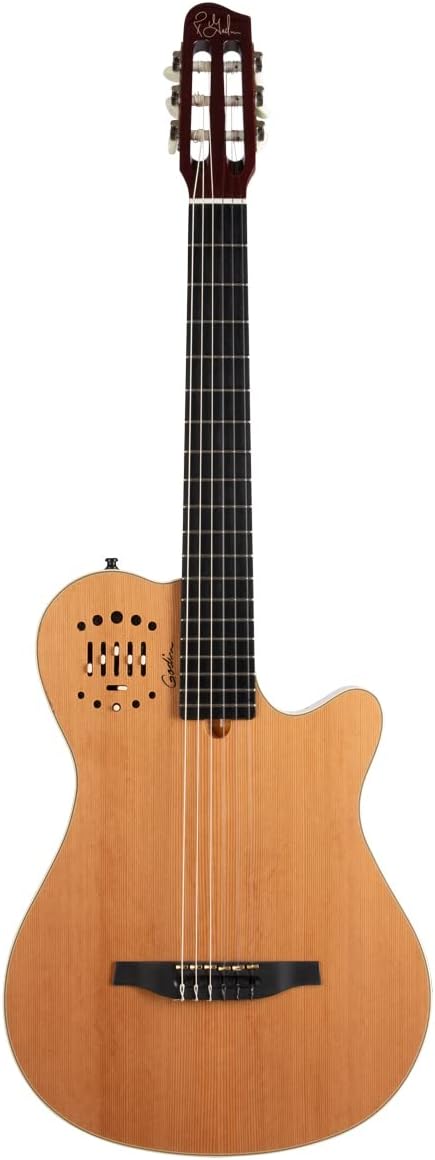
If you’re a classical guitar player looking for an electric model, the Godin MultiAc Grand Concert Deluxe Acoustic-Electric is a superb option worth considering.
This guitar stands out courtesy of its unique blend of materials. Mahogany is used for its body, neck, fretboard, and back, offering warmth and a richness of tone that players love.
In addition to the mahogany, the guitar’s top is a composite of both Cedar and Mahogany woods, adding a flavorful mix to the overall resonance.
It’s designed for right-handed players and comes with six nylon strings, popular amongst classical and flamenco players for their distinct sound.
Undeniably eye-catching, the guitar sports a natural finish, revealing the beautiful natural grain of the woods used, making each piece subtly unique.
Despite the organic look and feel, the guitar is not devoid of modern amenities. It features a Richlite fingerboard, a high-density material that imitates the best properties of exotic woods, but with more durability and consistency.
Lastly, given it’s an acoustic-electric, it ensures a great performance whether you’re playing unplugged or connected, bringing you the best of both worlds, the acoustic and electric realms.
- My Review
From my experience with the Godin MultiAc Grand Concert Deluxe Acoustic-Electric Guitar, it’s a versatile and exceptionally well-crafted instrument.
One of the dominant things that really caught my attention is the Mahogany Neck, which offers great resilience and durability in the long run.
When it comes to the top material, the combination of cedar wood and mahogany wood ensures a richer and warmer tone, perfect for classical music and fingerstyle play.
Given its hand orientation, I found the guitar exceedingly comfortable to play as my right-handedness was amply accommodated.
It has six nylon strings which I found to be very responsive and producing an authentic classical guitar sound.
Upon playing, you can observe the direct impact the string material type has on improved playing ease and the excellent tone quality.
You can’t help but admire, how the Mahogany Body contributes to the overall aesthetics while also influencing the sound characteristics in a unique way.
Nylon-string acoustic-electric guitar also comes with a richlite fingerboard, an aspect I found enhances the playability while offering a smooth feel on the fingers.
I must say that the acoustic-electric functionality of the guitar is truly a marvel, allowing the player a greater range of tonal options, very ideal for both stage performance and home practice.
As a cherry on top, the overall finish in natural color gives this instrument a sophisticated touch that sets it apart in terms of appearance.
Being a product from the renowned brand, Godin, you are assured of high standards of quality and audibility.
Despite its predominantly plastic body material, the guitar does not compromise on the sound quality nor the structural integrity.
The drawback, though, lies in its appeal to seasoned classical guitarists who may prefer a full wood construction to achieve the traditional acoustic feel and tone.
It’s evident that every part of this guitar, from the allergen-free richlite fingerboard to the durable mahogany neck, is designed with the player’s comfort in mind.
It’s not everyday that you come across a guitar as well-rounded as the Godin MultiAc Grand Concert Deluxe Acoustic-Electric Guitar.
- Pros:
- Top-quality materials used.
- Features richlite fingerboard.
- Combines acoustic and electric features.
- Cons:
- No significant negatives were found.
My final verdict is that the Godin MultiAc Grand Concert Deluxe Acoustic-Electric Guitar is an exceptional instrument.
It stands out for its sturdy and high-quality materials such as Mahogany and Cedar, providing durability and enriching sound quality.
With its Nylon-Strings, it gives classical players the convenience of an electric model.
Its Natural color is simple yet stylish, making a strong visual impression.
However, its right-hand orientation may not be suitable for everyone, which is a minor drawback to consider.
What Features Make a Good Acoustic Guitar for Gigging?
When considering which guitar may be best for gigging, a combination of features are important to take into account.
The sound quality of the guitar is paramount, as it will be amplified to reach an audience.
The guitar should be able to produce clear and loud sounds, to resonate well with other instruments and vocals on stage.
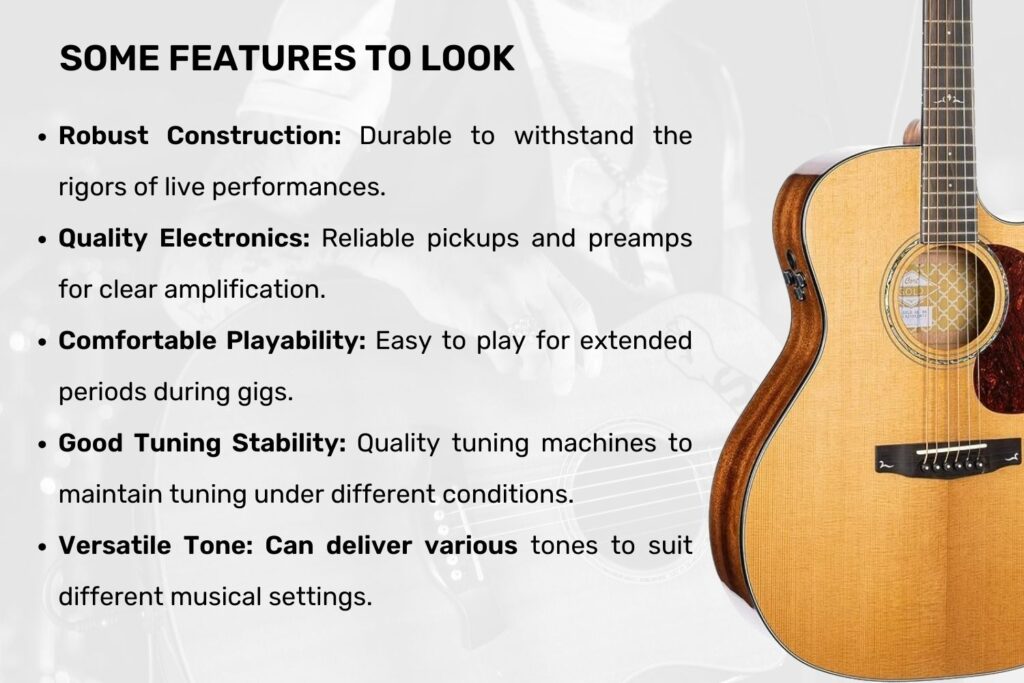
In addition, a good gigging guitar should also have a well-balanced tone.
Whether playing alone or in part of an ensemble, the bass, mid and treble ranges should all be accurately represented for the overall sound to be pleasing to the listeners.
Another important feature in the ideal gigging guitar would be the build quality.
Guitars that are constantly transported and exposed to different environmental conditions must be robust and stand up well to the rigors of travel.
Therefore, it’s crucial to have a guitar with a solid construction, resistant to bumps and knocks.
The wood choice in guitar construction can also greatly influence the sound and longevity of the instrument.
Hardware parts of the guitar too, like the tuning pegs, should be good quality and keep the strings in tune.
Besides, a gigging guitar should, of course, feel comfortable to play.
Frequently, this has to do with the dimensions of the neck width and profile, the setup of the strings, and the shape of the guitar itself.
Factors like the width of the fingerboard, the radius of the fretboard, and the shape of the neck can all contribute to how easy it is to play the guitar, especially over long periods of time.
This will greatly influence the efficiency of your performance on stage.
Few aspects of gigging guitars that sometimes get overlooked are the ease of maintenance and the accessibility to upper frets.
Having a guitar with a removable neck could make it easier to adjust the neck or to change strings quickly in the middle of a show, if necessary.
Similarly, a cutaway can make upper frets more accessible, allowing for more freedom and expressiveness in your performance.
Ultimately, the choice of a guitar for gigging often comes down to a balance of these factors, along with the guitarist’s personal style and preference.
Because every guitarist will have slightly different needs and priorities, it is always a good idea to try out a guitar in person before purchasing it.
Sound, comfort, build quality and ease of use are all important considerations to make when choosing the best acoustic guitar for gigging.
How Important Is Guitar Size for Gig Performances?
The size of a guitar is crucial for successful performances, particularly while gigging.
Guitars come in different shapes and sizes, each designed to produce unique sound deliverance which can affect the performance in various ways.
The guitar’s size significantly influences its sound projection and resonance
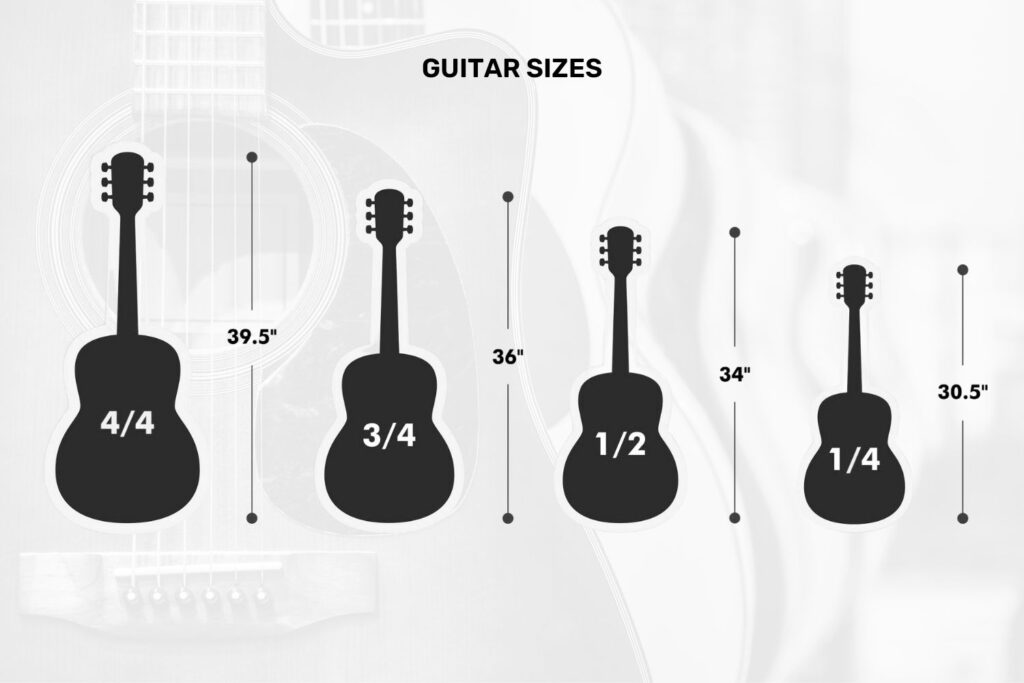
Typically, larger guitars have a louder volume and broader dynamic range than smaller ones due to bigger sound boxes which create stronger resonance.
The quality of the sound is thus heavily reliant on the size of your guitar.
Furthermore, the size of a guitar also determines its playability.
Larger guitars may prove difficult to manage and play comfortably for some players, especially those with smaller body frames or hands.
Meanwhile, smaller guitars are easier to hold and maneuver, making them perfect for individuals who prioritize comfortability and ease of play.
Therefore, it’s not just about how good a guitar sounds, but also if it feels right in the hands of the person playing it.
Another key point to consider is the artifact’s portability.
As gigs commonly happen in various locations, it’s essential for musicians to have a travel-friendly instrument.
Smaller guitars are usually preferred for gigging, as they are easier to transport. They often come with specially designed carrying cases that offer protection while on the road.
Keep in mind, though, a smaller guitar doesn’t necessarily mean inferior sound.
Many manufacturers have gone through great lengths to engineer smaller guitars so they sound just as good as their larger counterparts.
Finally, the musician’s comfort and the guitar’s aesthetics play an equal role here.
A guitarist can perform better when they’re relaxed and at ease; a comfortable size of guitar contributes to the artist’s concentration during playing.
Guitar size affects aesthetics as well.
A large guitar could be imposing and grand, making it a captivating part of the performance, while a small guitar might offer a casual and intimate feel.
Ultimately, one’s guitar size choice for gigging should be a fine balance between comfortability, sound quality, practicality and personal preference.
Is the Wood Type Crucial for Sound Quality in Gigging Guitars?
The importance of the wood type in the construction of a guitar cannot be underestimated, particularly when it comes to performing live or gigging.
This is because different varieties of wood possess unique acoustic properties that influence the overall tone, resonance, and projection of the instrument.
For instance, hardwoods like mahogany are renowned for their dense, warm tones and sustained resonance, making them a favoured choice among many professional musicians for live performances.
On the other hand, softwoods such as spruce are known for a brighter, crisper sound with higher resonance, which can blend beautifully in an ensemble setting.
Much of the guitar’s individual character and tone depend on the type of wood used for the top, back, sides, and neck of the instrument.
For instance, a guitar with a maple back and sides, combined with a spruce top, often produces a bright, clear tone with excellent projection, suitable for a more striking aural presence.
Another critical factor is the species of wood used in the fretboard or fingerboard of the guitar.
In many quality guitars, rosewood or ebony is used because of their durability, resilience to wear and ability to deliver a smooth, even tone.

It should also be noted that the type of wood used in making a guitar impacts the instrument’s playability and durability over time.
Hardwoods tend to respond well to the rigors of frequent playing and changes in humidity and temperature, making them suitable for gigging situations.
In contrast, guitars made from softer woods may require more maintenance to keep them in optimal playing condition when frequently played in different venues with varied environmental conditions.
Furthermore, the quality of sound and resonance that individual species of wood produce can also evolve over time, with use and exposure to different environments, adding a whole new dimension to the character of the sound.
An experienced luthier, the artisan who crafts guitars, can match different types of wood together to create a unique sound palette for a specific guitar, a technique often found in high-end, custom-made instruments.
It is evident that the wood type plays a substantial role in shaping the sound quality of a guitar for gigs.
Therefore, it is vital for performing musicians to understand and consider the influence of different types of wood in the construction of an acoustic guitar as they search for the perfect instrument to bring their music to life on stage.
What Role Does the Shape Play in Acoustic Guitars for Gigs?
The shape of an acoustic guitar is a key factor largely affecting its overall sound, playability, and its suitability for gig performances.
Firstly, it’s important to recognize that a guitar’s shape determines the volume, tone, and resonance of the instrument.
A large-bodied guitar generally produces more volume and bass frequencies, making it ideal for strumming and traditional folk music.
On the contrary, a smaller-bodied guitar, like a parlor or concert guitar, typically results in brighter tones and stands out more when playing fingerstyle.
When it comes to gigging, the shape also influences how comfortable the guitar is for stage performances.
Playing a large, jumbo-sized guitar could prove unwieldy for a smaller musician, impacting their stage presence and maneuverability.
Alternatively, a more compact model might be easier to handle on stage, allowing the guitarist to move freely and put on a more engaging show.
Uniquely shaped acoustic guitars, like the dreadnought or auditorium styles, can also create distinct soundscapes indispensable for certain musical genres and playing styles.

Guitarists who prefer a dark, rich tone might opt for a dreadnought shape, while those who prefer a balanced, versatile sound could choose an auditorium or grand auditorium model.
Furthermore, the shape of the guitar can significantly affect the instrument’s feedback control during live performances.
Guitars with smaller bodies are often less prone to feedback problems compared to those with larger bodies.
This is a factor to consider if you are playing in loud venues with amplified sound.
With this understanding, musicians can select a guitar shape that best matches their specific gig needs, whether it’s a robust dreadnought for strumming chords, a versatile grand auditorium for playing various musical styles, or a comfortable concert guitar for fingerpicking.
However, it is important to remember that although the shape of an acoustic guitar plays a significant role in determining its sound and playability, it is only one aspect of the overall mix of features that creates an exceptional instrument for gigging.
Other aspects such as the tonewood, bracing pattern, and even the instrument’s finish can all contribute to the guitar’s overall timbre, resonance, and tonal projection.
The guitar’s shape, therefore, should be considered in conjunction with these other factors when choosing the perfect acoustic guitar for gig performances.
Why Choose a Steel String Guitar for Gigging?
When it comes to picking the right guitar for a gig, the type of string you choose can play a significant role in how your performance is perceived.
Steel strings, in particular, are often the top choice for musicians who play live.
This is because they are renowned for producing a bright and loud tone, which is perfect for performing in front of live audiences.
Moreover, steel strings are traditionally easier to pick compared to other types like nylon, making them ideal for fast and dynamic playing styles often seen in gig performances.
Another significant advantage of using steel strings is their rich harmonic content.
They deliver a full-spectrum tonal quality, which may not be as easily achieved by nylon or gut string instruments.
This means that the guitar’s sound tends to fill up the sonic space more completely, cutting through the mix of the band and reaching all corners of the audience with clarity.
Furthermore, the resistance and tension offered by steel strings are also beneficial for gigging musicians.
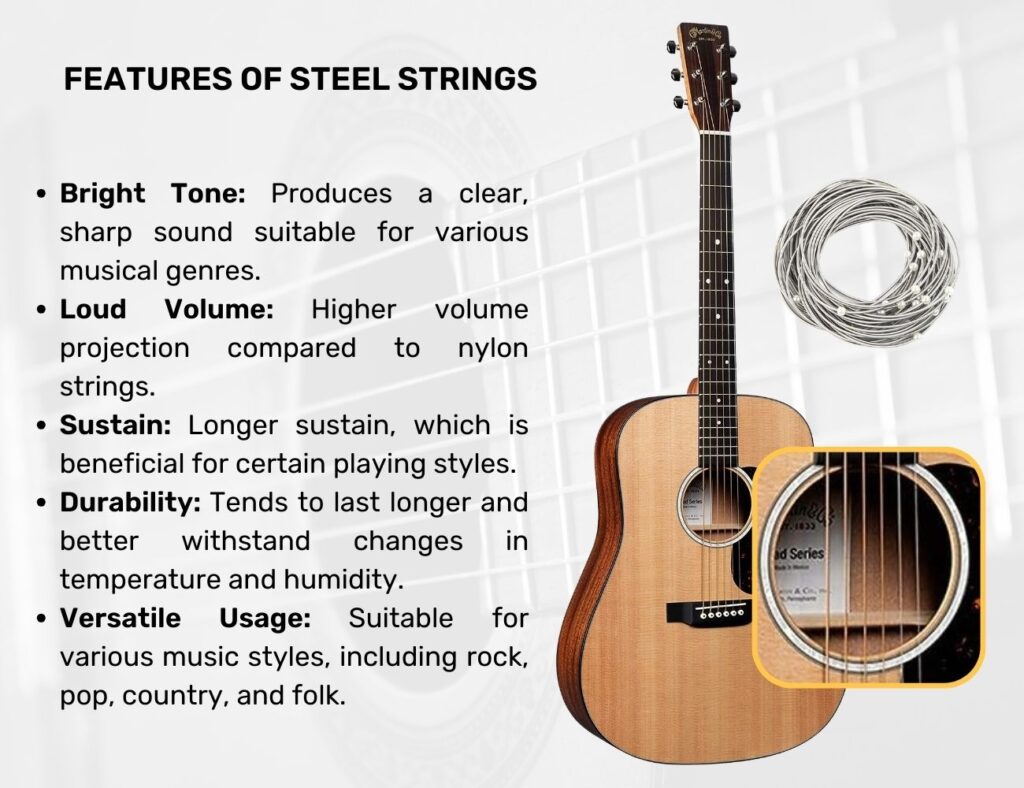
These characteristics provide a consistent feel under the fingers, allowing for precise articulation and responsiveness during a performance.
On the downside, steel strings can be quite tough on the fingers, especially for beginner players.
But, with regular practice and use, your fingers will eventually develop the necessary calluses to withstand the tension of steel strings, thus preventing discomfort during long gigs.
It’s important to note that choosing a steel string guitar for gigging also means you’ll need a guitar built to withstand the higher tension of these strings.
Primarily, this relates to the construction of the guitar, meaning you’ll typically be looking at dreadnought or jumbo style guitars when considering steel strings.
Furthermore, you’d want a guitar with a truss rod, an internal reinforcement that counterbalances the tension exerted by the steel strings, to maintain the correct neck curvature and prevent warping over time.
Apart from the sound and playability, the use of steel strings can also open up a variety of stylistic choices for gigging musicians.
Genres such as folk, country, rock, blues, and pop often primarily feature steel-string guitars, so if these styles align with your music, then a steel-string guitar would be a sound choice.
The decision to opt for a steel string guitar for gigging is dependent on several factors including the type of music you play, the venues you perform at, and your level of comfort and experience with playing steel string guitars.
But, with their ability to project a loud, bright sound filled with rich harmonics, coupled with their high playability and wide-spread use in popular music genres, steel string guitars have proven to be a reliable choice for many gigging musicians.
What Are the Benefits of Cutaway Designs in Gigging Guitars?
Performing on stage often necessitates certain modifications in the design of an acoustic guitar. The cutaway design is one such popular modification that many professional musicians prefer for their performance guitars.
Essentially, a cutaway is a dent or an indent in the body of the guitar, reducing mass near the neck and allowing greater accessibility to the upper frets.
Most acoustic guitars for stage performances come with either a single cutaway, also referred to as a ‘venetian cutaway’, or with a double cutaway, commonly known as a ‘florentine cutaway’.
A great advantage of the cutaway design is the ease of playing. This design alters the accessibility to upper frets, making it easier to play higher-pitched notes.
Often, in a live performance, a guitarist is required to transition swiftly between varying pitch notes, and the cutaway design allows for that swift transition while facilitating precision.
Also, the increased access to upper frets opens up an entire range of octave possibilities and allows the guitarist an extended tonal range during a gig.
A cutaway might very subtly alter the tonal quality of the guitar.
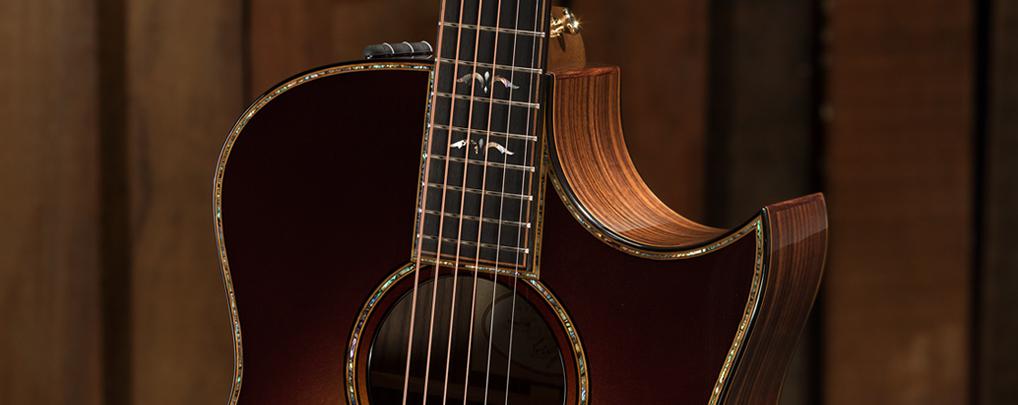
As a portion of the guitar’s body is removed to create the cutaway, it might reduce the resonating chamber inside the guitar, potentially slightly affecting its tonal quality.
However, this change is exceptionally minor and usually not noticeable, especially in a live performance scenario where the overtones are not as discernable as in a recording.
Most guitarists agree that the benefits of easier fret access far outweigh any negligible shift in tone.
In terms of aesthetics, many musicians feel that the cutaway design looks contemporary and sleek.
It adds an exciting element to the visual aspect of their performance.
Especially for those performers who favor a modern aesthetic in their stage setup, a cutaway guitar might be just the right fit.
The same goes for comfort. It enhances the overall comfort in holding and playing the guitar, particularly when the musician is performing for extended periods.
Notably, the cutaway design is more predominant in electro-acoustic guitars, which are most commonly used in live gigging situations because they allow for amplification.
For electro-acoustic guitars, a cutaway does not have as pronounced an impact on the sound as it does on purely acoustic instruments.
Even though the cutaway feature can present several advantages, ultimately, it’s a matter of personal preference.
Some musicians might prefer the standard design for a variety of reasons including tradition, tone, or aesthetic preference.
It’s important to mention that the presence or absence of a cutaway does not necessarily make a guitar better or worse.
Rather, it’s more about how the guitar fits the particular needs and preferences of the musician.
So when it comes to choosing a guitar for gigging, considering all factors — including the potential benefits of cutaway designs — can help you find the right instrument for your stage performances.
How Do You Care for an Acoustic Guitar Meant for Gigs?
When it comes to maintaining the optimum sound quality and aesthetics of your acoustic guitar, certain measures are crucial to be taken into consideration.
First and foremost, the routine of cleaning your guitar after every performance is essential.
Apart from the dust that finds its way to your guitar, the natural oils of your fingers also contribute to the gradual accumulation of grime on the fretboard and strings.
Regularly keeping your guitar clean ensures the longevity, aesthetics and overall performance of the guitar.

Moreover, it is highly recommended to use a specialized cleaner for your guitar, as common household cleaners can be potentially harmful.
Next, maintaining the revitalization of your guitar’s fingerboard is also pivotal in ensuring the instrument’s sustainable performance.
You should apply oil to the fretboard periodically to prevent it from drying out and cracking.
This is especially crucial for guitars with rosewood or ebony fretboards, as these woods tend to lose their natural oils more quickly.
Further, the adjustment of guitar’s action is a paramount aspect to consider.
The term ‘action’ refers to the height of the strings above the fretboard
This height affects your ability to perform swiftly on the stage, and too high of an action makes it harder to press down the strings, while too low action can cause buzzing.
This adjustment should only be performed by a skilled technician to prevent potential damage to the guitar.
Additionally, regular changing of guitar strings is vital for maintaining a vibrant and clear sound.
Depending on how often you gig, you will need to replace your strings every few weeks to a few months.
Old strings are prone to breakage and can cause several tuning issues which could jeopardize your performance understandably.
Finally, it is crucial to invest in a quality guitar case to protect your instrument from potential physical harm and environmental elements.
A robust case or gig bag protects your acoustic guitar from potential impacts, while the padding inside provides cushioning during transportation.
When your guitar is not in use, keeping it in a case also protects it from the dust that can, over time, impact the strings and the fretboard.
Equally critical is to avoid exposing your guitar to sudden temperature and humidity changes.
Extremely low or high temperatures and humidity can lead to warping of the wood, causing a permanent deformation of the guitar and changing the tone it produces.
A good quality guitar case is often designed with material that wards off extreme temperatures and helps to maintain the guitar’s appropriate humidity level.
Apart from the above-mentioned points, tune-ups and check-ups with a professional luthier will prevent minor issues from turning into severe problems and ensure the longevity of your acoustic guitar.
Remember, caring for your guitar is an ongoing process and will ensure that your guitar remains at its best, ready for any gig you have on your schedule.
What Type of Guitar Strings Are Ideal for Gigging Acoustic Guitars?
The selection of strings is a crucial aspect of optimizing your guitar’s sound for gig performances.
String gauge, the thickness of the strings, plays a significant role in your guitar’s tone and playability.
For gigs, where volume and presence are crucial, many professionals choose to utilize medium gauge strings.
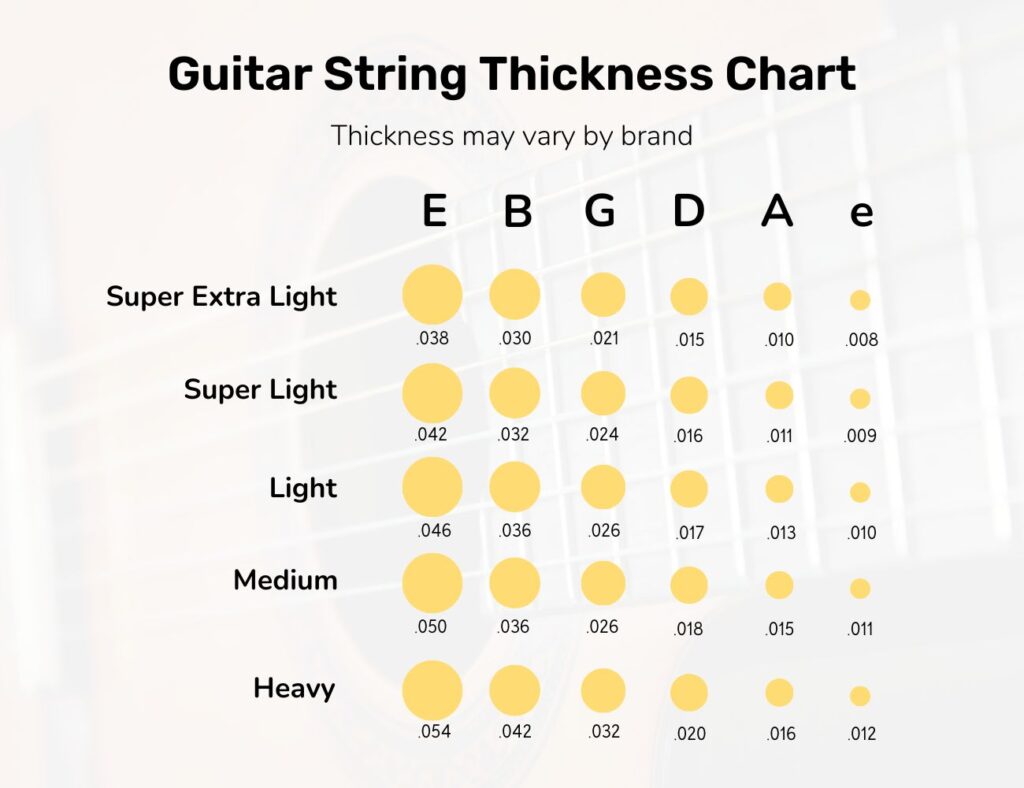
These types of strings, generally ranging from .012 to .054 inches in width, give a robust and loud tone that can fill up a crowded venue.
In addition, medium gauge strings have a higher tension which can provide a fuller sound and additional sustain, which is ideal for live performances.
However, they might also require extra finger strength and can potentially be more challenging to play for longer periods, especially for beginners or guitarists with a lighter touch.
Many professional gigging guitarists also consider string material in their choice of strings.
Phosphor bronze strings, known for their warm, bright, and balanced tone, are often a favorite among gigging musicians.
Bronze strings, cheaper than phosphor bronze, can also be used for gigs because they produce a clear, ringing tone that cuts through the mix especially in a band setting.
If you are looking for something that offers a distinctive, crisp tone with good note separation, coated strings make an excellent option.
These are resistant to sweat and dirt hands, making them the perfect choice for long gigs as they last significantly longer.
Then, there’s string winding, another integral aspect to consider.
Roundwound strings are the most common type used on guitars due to their bright tone and excellent sustain, ideal for cutting through in a live gig.
Flatwound strings, though less common, create a smoother, darker tone that some guitarists prefer for their unique sound.
It’s worth noting that the choice of strings also relies heavily on personal preference and the specific sound a musician is aiming for in their performance.
Trying out different types and gauges is encouraged to discover what suits you and your style the best.
Ultimately, the ideal strings for your acoustic gigging guitar will depend on several factors: the guitar’s construction, your playing style, and the specific sound you wish to project in your performance.
What Is the Role of a Guitar’s Neck Width and Profile for Gigs?
When considering the components that contribute to the overall performance of an acoustic guitar on stage, the neck width and profile play pivotal roles.
The neck of a guitar is critical as it navigates the playability and comfort of the instrument, making it an essential feature to consider for gigging situations.
In terms of neck width, wider necks typically allow for more spacing between the strings.
This extra space can be beneficial for intricate fingerstyle arrangements, providing the player with more room to maneuver.
However, it is important to note that guitars with wider necks can be more challenging for those with smaller hands or those who are accustomed to narrower necks.
Thus, while a wider neck can provide certain advantages, it may not be ideal for everyone.
On the other hand, guitars with narrow necks often make it easier to reach all six strings.
This is particularly beneficial for performers who frequently switch from rhythm to lead parts or those who often use barre chords.
The neck’s thickness or depth, commonly referred to as the profile, is another significant aspect to consider.
Thicker or chunkier neck profiles can provide a sturdier grip, which many guitarists find beneficial.
Again, the preference for a thick or thin neck usually comes down to personal comfort and the genre of music played.
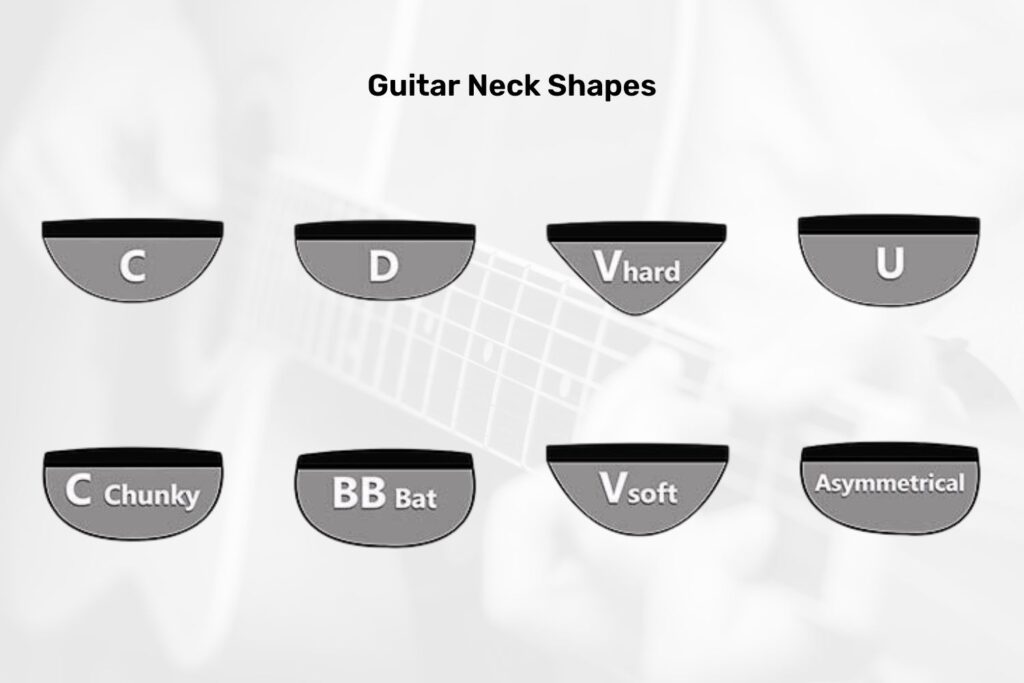
The shape of the neck profile, whether it’s the traditional “C” shape or the modern “D” shape, can also affect the guitar’s feel and playability.
For example, a “D”-shaped neck tends to be flatter and can be more comfortable for some guitarists to play on, thereby affecting their performance during a gig.
Neck construction is another facet that should not be disregarded.
Necks made from multiple pieces of wood tend to be sturdier and are less likely to warp compared to single-piece necks.
However, some guitarists believe that single-piece necks result in better vibration transfer, enhancing the overall tone of the guitar.
Ultimately, the choice between a wide or narrow neck, a thick or thin profile, a “C” or “D” shape, or a single-piece or multi-piece construction all comes down to personal preference.
It’s also important to remember that these variations in neck size and profile can have significant differences in feel and comfort when playing, which, in turn, can impact a musician’s performance during a gig.
Therefore, before purchasing a guitar for gigging, it is critical to try out different neck widths and profiles to see which one synchronizes best with one’s playing style and comfort.
It is also advisable to converse with other guitarists and seek their advice or experiences regarding different guitar neck profiles and widths, especially if they often play gigs.
Doing so can provide a clearer understanding and maybe even pave the way towards a more informed decision.
In a nutshell, while the specific guitar’s body, wood type, and strings are all critical factors for onstage performances, it’s the neck width and profile that may have the most direct impact on your playability and comfort.
To ensure a seamless and enjoyable gig performance, prioritizing the fit and feel of the guitar neck is an absolute must.
The Bottom Line
After analyzing various acoustic guitars for gigging, it’s clear that some models stand out among the rest.
The right guitar for you depends on your personal requirements and the type of music you play.
The best guitars are not just about sound quality, but also about ease of use during live performances.
Therefore, factors like build quality, comfort in handling, and the ability to project sound clearly in a live setting are crucial.
Consider these key points when choosing your next gigging guitar and rest assured you’ll find one that perfectly complements your music journey.
Sources: sweetwater.com ; guitarcenter.com ; guitarworld.com
In love with guitars, and gear; expert in all things music! Been writing about guitars for about 5 years and counting. Born in the ’90s. Alma Mater: University of Havana. Always curious, trying to understand the world. #TeamFender




